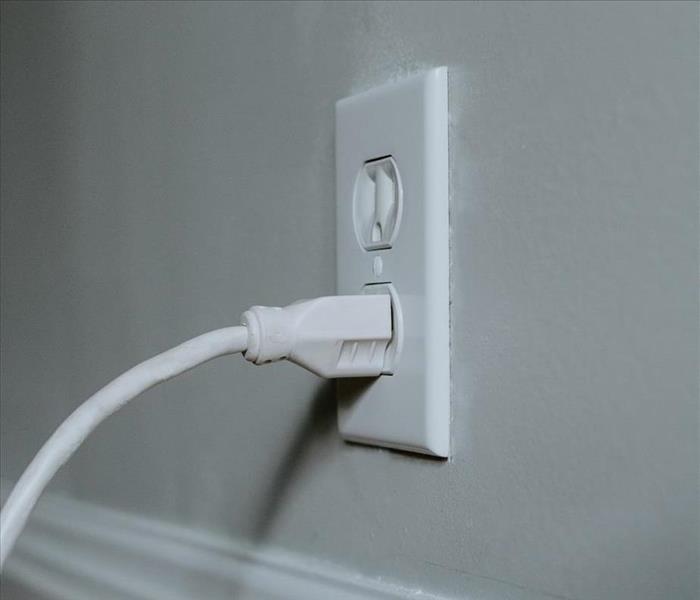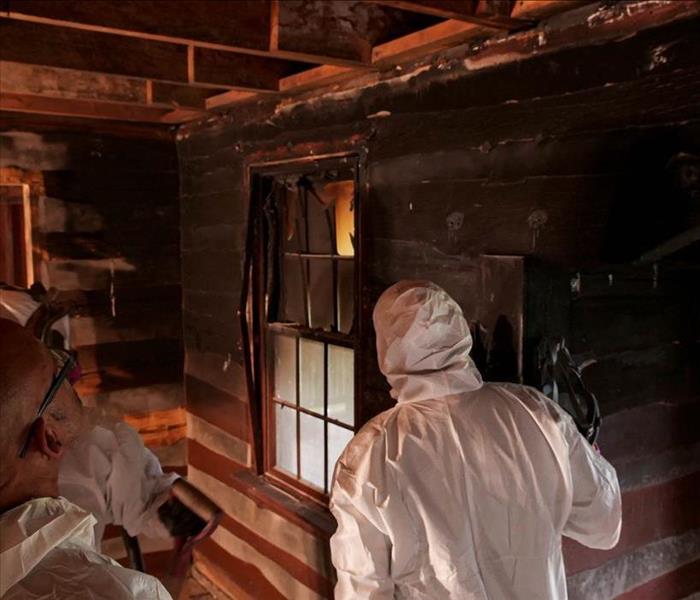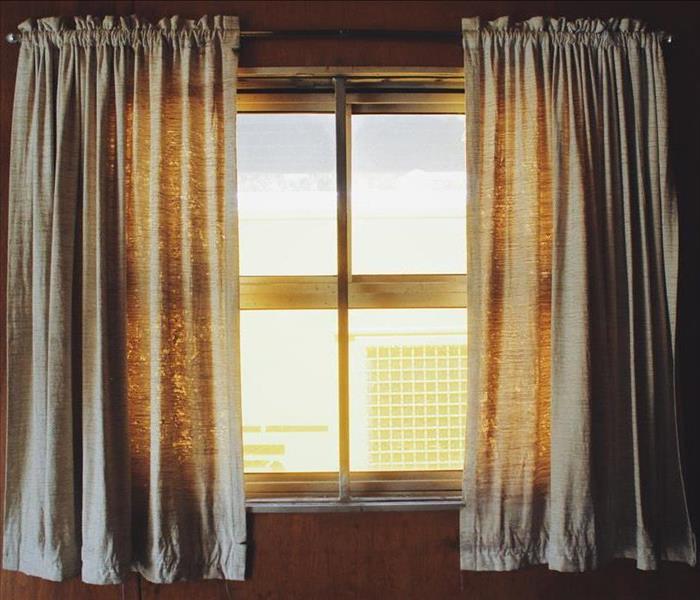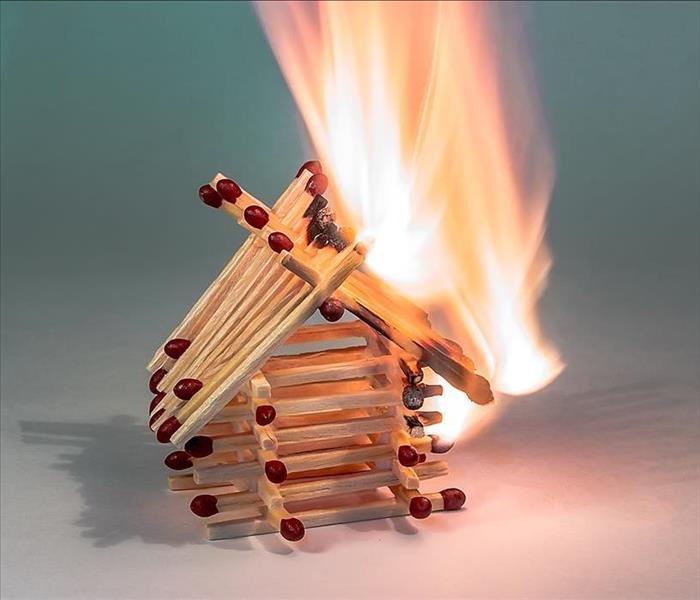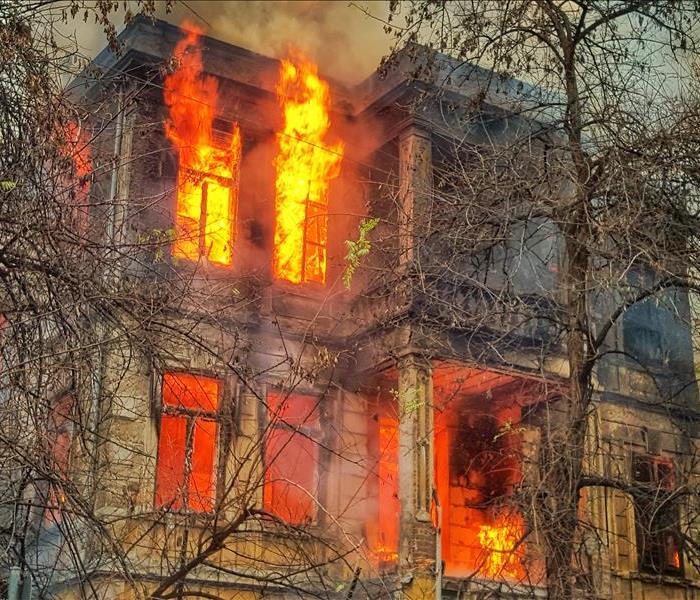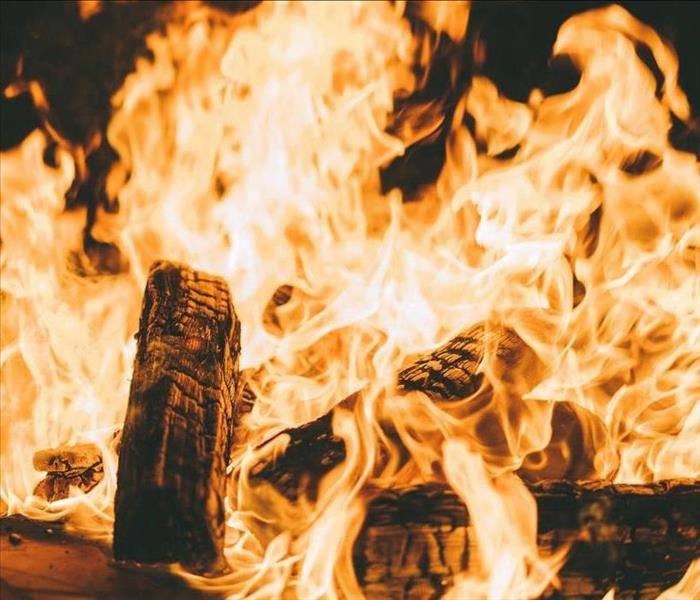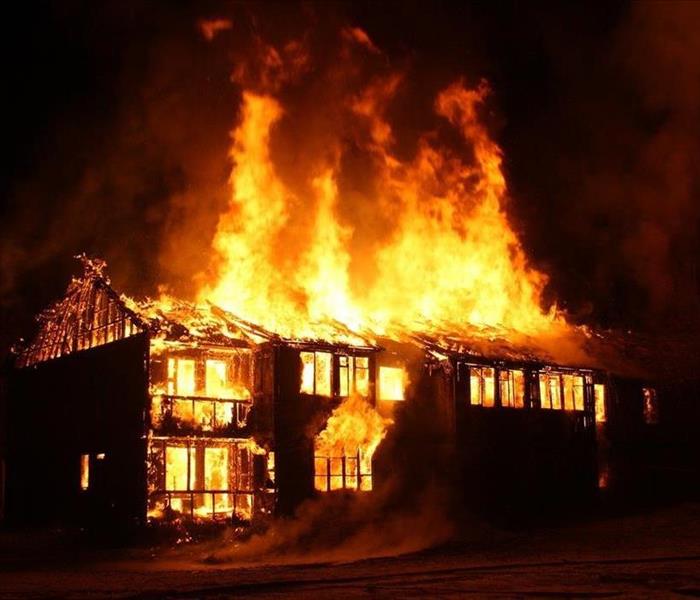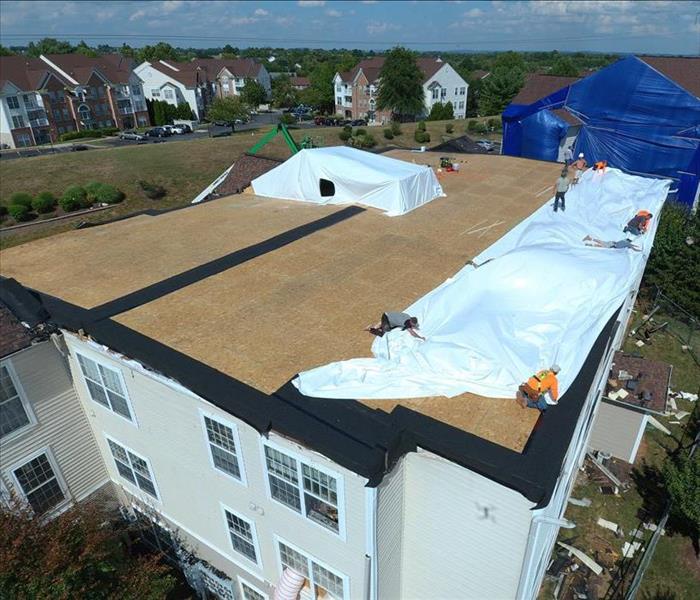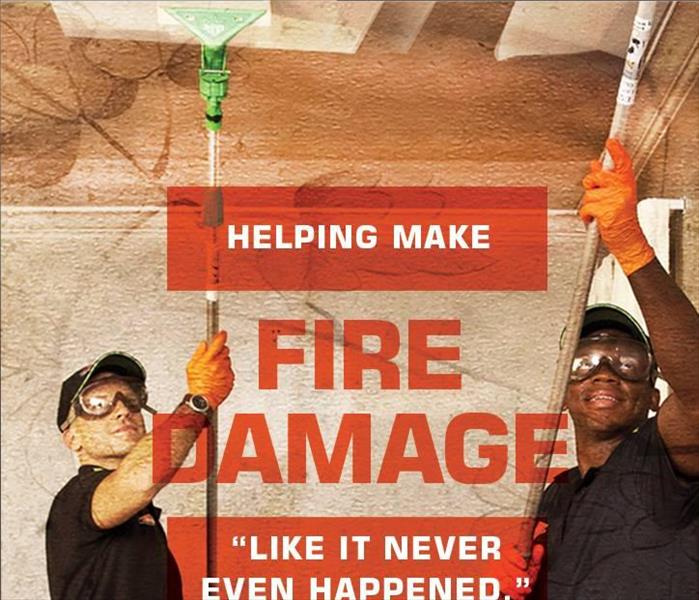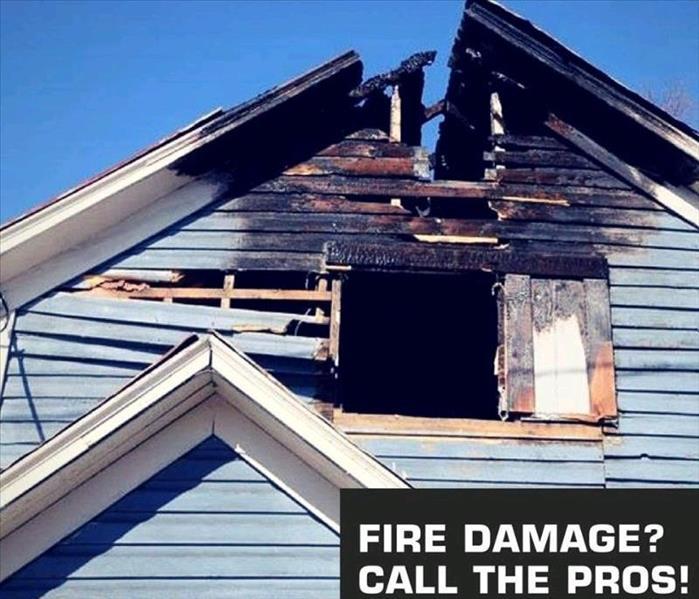Recent Fire Damage Posts
Be Prepared for Kitchen Fires
12/26/2022 (Permalink)
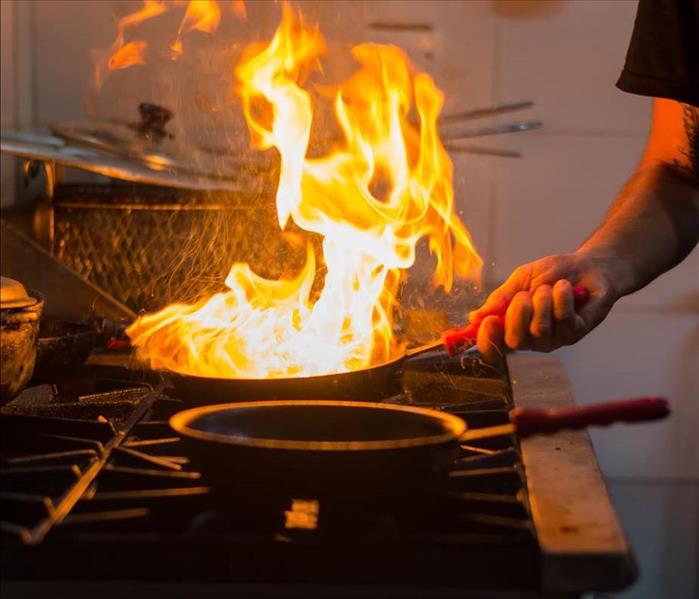 Consider these 3 proactive fire safety tips that are beneficial to keep in mind while cooking in the kitchen.
Consider these 3 proactive fire safety tips that are beneficial to keep in mind while cooking in the kitchen.
Year-round – but especially during the holidays – the kitchen is a known gathering space. In 2019, according to the National Fire Protection Agency, Thanksgiving saw the peak of home cooking fires, followed by Christmas Day and Christmas Eve. This emphasizes an increase in home cooking fires during the holidays. This holiday season, there are two critical steps you can take as a homeowner to promote fire safety in your kitchen: developing an understanding of potential fire hazards in the kitchen and learning the ins and outs of fire safety practices. In today’s blog, we’ll share 3 proactive fire safety tips that are beneficial to keep in mind while cooking.
1. Create Space in Your Kitchen
Instituting a “kid-free zone” in your kitchen is one option promoted by the NFPA, aimed at maintaining a safe amount of space between children and potentially dangerous cooking areas. This idea, however, can be helpful for any guest in the kitchen – not just children. Keeping at least 3 feet between kitchen guests and cooking equipment like stovetops and ovens can make a significant difference in preventing fire-related kitchen emergencies.
2. Keep a Lid Nearby
The NFPA reports that the kitchen stove plays a key part in the majority of kitchen fires. If a small fire ignites while you are cooking on the stove, having a lid at arm’s reach can be a beneficial safety precaution. In the event that a small fire ignites, slide the lid over the pan and turn the burner off completely in order to smother the fire. It is important to keep in mind, however, that this tip cannot be applied to oven fires. If a fire ignites in your oven, be sure to instead keep the oven door closed and turn off the oven.
3. Be Prepared to Handle a Fire
Upon discovering a fire in your kitchen, a quick decision to either fight it or call for help must be made. Even though action must be taken swiftly, it is important that your decision is a thoughtful and smart one. If you are unsure of your ability to effectively extinguish the fire, do not hesitate to call 911, close the door to the kitchen to prevent the fire from spreading, and get everyone out of your home quickly and safely. If, on the other hand, the fire is small, you have a fire extinguisher nearby, and you feel confident in your ability to extinguish it, it is possible that you could handle it on your own. If there is ever any doubt in your mind, it is always best to call 911 out of an abundance of caution.
Call SERVPRO Team Wall for Residential Fire Damage Restoration
After any residential fire damage situation, take comfort in knowing that SERVPRO Team Wall is always here for you. Team Wall is available 24/7 for professional residential Fire Damage Restoration services. We are just one call away and always here to help quickly restore your home to its preloss condition. Learn more information about our fire-related capabilities, such as removing smoke odors, protecting your fire damaged belongings, and rebuilding fire-damaged structures, check out our website. Pick up the phone and give our SERVPRO of Metro Pittsburgh East office a call at (412) 672-5400 today to learn additional information about our Fire Damage Restoration offerings. Trust SERVPRO Team Wall to help make it “Like it never even happened” in the aftermath of any fire emergency.
Heating Equipment: Practicing Fire Safety
10/14/2022 (Permalink)
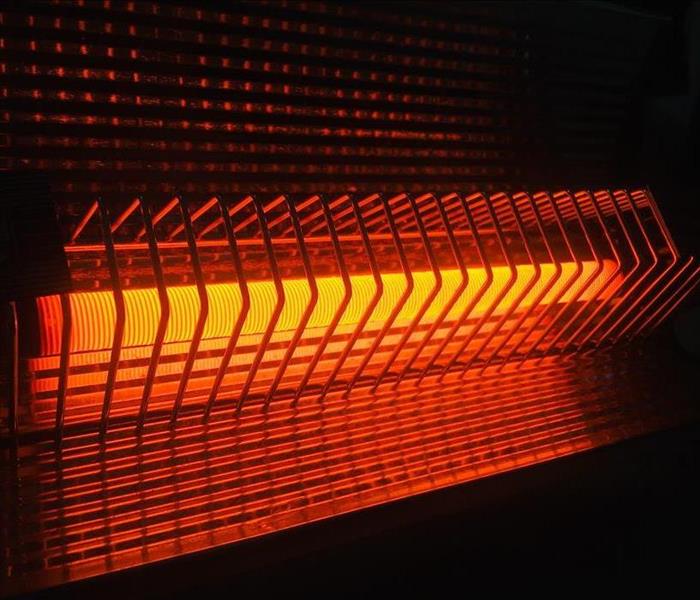 It is always important to discuss fire safety when using any type of heating system in order to decrease fire risk.
It is always important to discuss fire safety when using any type of heating system in order to decrease fire risk.
The chill in the air only means one thing: It’s getting to be that time of year again when the temperature drops and we begin thinking about turning on our home or business’ heating system. It is always important to discuss fire safety when using any type of heating system in order to decrease fire risk. Today’s blog will take 3 statistical observations from the National Fire Protection Agency into consideration in order to discuss a few different ways in which you can prevent your property from becoming part of the statistics.
1. “Most home heating fire deaths (81%) involved stationary or portable space heaters.”
Decrease your home or business’ fire risk by keeping objects, especially those that are combustible like blankets and upholstery, at least 3ft away from portable heaters at all times.
2. “The leading factor contributing to home heating fires (25%) was failure to clean, principally from solid-fueled heating equipment, primarily chimneys.”
Soiled-fueled heating systems, such as chimneys, should be cleaned by professionals of a yearly basis. Annual chimney inspections and cleanings can help decrease your property’s fire risk.
3. “Nearly half (48%) of all home heating fires occurred in December, January and February.”
During the colder months, it can be tempting to keep hearing sources working 24/7. However, fires can ignite when heaters are unsupervised. When you leave the room or go to bed, be sure to turn off your portable heater.
Call SERVPRO Team Wall for Fire Damage Restoration Services
On our website, you can find more Fire Tips, in addition to information about our Fire Damage Restoration services and Fire Restoration Process. In the colder months to follow, call SERVPRO Team Wall at (412) 672-5400 if your home or business experiences fire damage this fall or winter. Trust our team’s experience and expertise to make it “Like it never even happened.”
Fire Safety Tips: Fire Pits
9/10/2022 (Permalink)
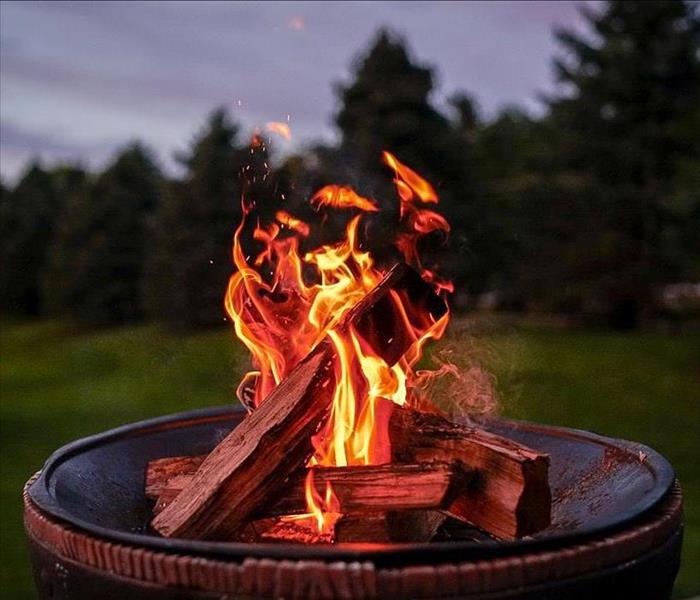 Taking fire safety precautions such as those listed in this blog can decrease the risk of fire damage to your property.
Taking fire safety precautions such as those listed in this blog can decrease the risk of fire damage to your property.
Though we’re still feeling the summer heat and fall seems to be far away, we’ll start to experience colder temperatures as we approach October. Fall is prime time for s’mores, apple cider, time spent outdoors, and of course, fire pits. According to the National Fire Protection Association, fire pits and campfires can facilitate accidents that may lead to injury if safety guidelines are not followed. Keep reading to learn ways in which you can safely use a fire pit and prevent fire damage to your property this fall.
Fire Safety at the Fire Pit
Two different types of fire pits can be purchased for properties: in-ground and above-ground. Both types must be kept at a safe distance away from your home, in addition to any combustible objects on your property, like sheds, trees, bushes, and other types of brush. Your fire pit should also be built from a non-combustible material, heavy metal, brick, or stone, in order to reduce fire risks. To prevent a fire emergency, a responsible adult should supervise the fire pit at all times whenever a fire is actively burning in the fire pit.
Make Safety a Priority
Be informed about your fire pit’s fuel safety protocols in order to protect your property. If you have a wood-burning fire pit, be sure that you use dry, clean wood. If your fire pit is not wood-burning, it is crucial that you follow the safety guidelines of your fuel type. These safety precautions may seem obvious, but a small oversight can have a significant impact on the safety of your property. Taking fire safety precautions such as those listed in this blog can decrease the risk of fire damage to your property, but accidents happen. For this reason, it is beneficial to always have a fire extinguishing device at the ready when using your fire pit. A fire extinguisher is a helpful tool, but a garden hose or bucket of water sitting nearby are also sufficient tools that can quickly douse a fire in an emergency.
Have a Fire? Call SERVPRO
Emphasizing fire safety is of the utmost importance, but if disaster strikes unexpectedly, SERVPRO Team Wall has your back. Available to you 24/7 with our 24-Hour Emergency Services, our professional team of experienced fire damage restoration technicians will work diligently to restore your property to its preloss condition. make it “Like it never even happened” after fire emergencies large and small. To learn more about our fire restoration services, pick up the phone and call SERVPRO of Metro Pittsburgh East today at (412) 672-5400 and check out our website, which features ample fire damage restoration resources, including our Fire Damage Restoration services overview, Fire Restoration Process, and Fire Damage Tips pages. To make it “Like it never even happened” after fire emergencies large and small, look no further than SERVPRO Team Wall.
After a Fire: What Not To Do
8/12/2022 (Permalink)
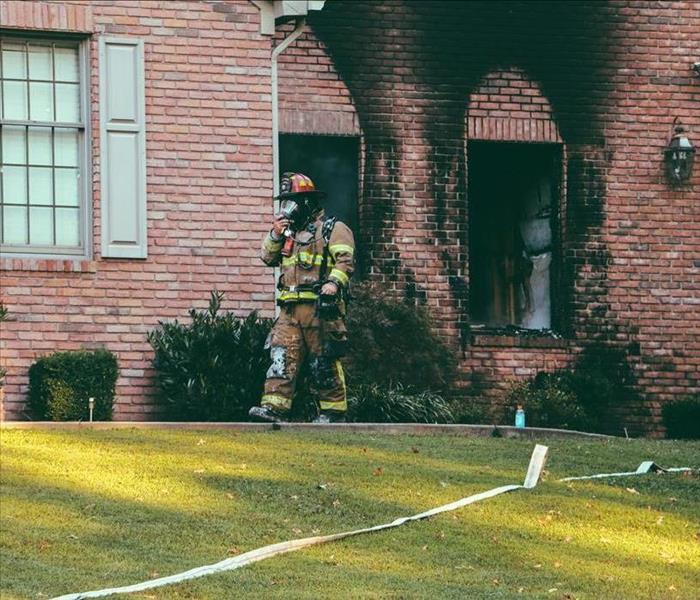 Taking hasty actions after a fire can risk additional damage to a property already suffering from fire damage.
Taking hasty actions after a fire can risk additional damage to a property already suffering from fire damage.
Fires, as we know, disrupt daily life for residential properties and regular operations for commercial properties. As a property owner, your mind is likely fixated on what you can do to restore your home or business to its pre-fire condition as soon as possible. While this thinking may be productive, taking hasty actions after a fire can risk additional damage to a property already suffering from fire damage. Continue reading for more information about actions to avoid after a fire in an effort to protect your property from additional, avoidable damage.
1. Re-entering Your Home or Business Before It Is Safe to Do So
Although the fire may be extinguished, it is not necessarily safe to re-enter the property. It is understandable for property owners to be anxious to re-enter their home or business after a fire in order to assess the damage. However, it is important to remember that entering a fire-damaged property prematurely can result in an increased risk for additional damage.
2. Cleaning The Property Yourself
Small and large fires alike can bring about smoke and soot residue, which can both risk damage to a property’s contents, as well as its ceilings and walls. Calling a fire damage restoration professional is beneficial, therefore, in order to make sure that the property is thoroughly restored and cleaned with professional, tested, and reliable methods and tools. Taking matters into your own hands, especially when it comes to washing carpets and walls, only risks further, unwanted damage. By contacting SERVPRO Team Wall instead, your property will receive the highest quality care, making your fire damage “Like it never even happened” after any emergency.
3. Using or Cleaning Electrical Appliances
Remember that in the early stages after a fire, areas of the property can be damp or soaked from fire extinguishing efforts. Therefore, it is important to avoid using electrical devices and appliances in an effort to prevent electrical shock. Because fires are extinguished with water, the wiring of electrical appliances, such as televisions, computers, refrigerators, and washing machines, can be left damp and dangerous to use. This is why it is best to also leave the task of cleaning electrical appliances to the professionals, who can make sure that everything is completed safely.
Call SERVPRO After a Fire
Making the call to SERVPRO Team Wall after a fire is the best way to ensure exquisite care for your property. Let our trusted restoration and cleaning services, experienced crew members, and advanced technology give you peace of mind after an emergency. You can learn more about our fire damage restoration offerings, including our commercial and residential Fire Damage Restoration Services overviews, Fire Damage Restoration Process, and our approach to caring for your fire-damaged belongings, all on our website. At the first sign of damage, pick up the phone and call SERVPRO of Metro Pittsburgh East at (412) 672-5400 to make it “Like it never even happened” and restore your home or business to its pre-fire condition as soon as possible.
Enjoying the Fireworks Safely This Summer
6/23/2022 (Permalink)
 The number of fires started by fireworks, as reported by the NFPA, exceeds 19,500 each year.
The number of fires started by fireworks, as reported by the NFPA, exceeds 19,500 each year.
Fireworks, the 4th of July, summer celebrations: these things all go hand-in-hand. We all know, however, that while fireworks are a summer staple, they come with their fair share of fire safety hazards. Consumer fireworks, which are the type of fireworks that are marketed to the public and do not require a permit to handle, lead to thousands of injuries each year, according to the National Fire Protection Agency. If large fireworks are not handled by professionals, fires, devastating burn injuries, and even death can be among the consequences. Prior to your firework-filled summer festivities, it is beneficial to learn about the fire safety risks of fireworks in order to prevent unwanted fires and fire damage.
Fireworks and Their Fire Safety Hazards
The number of fires started by fireworks, as reported by the NFPA, exceeds 19,500 each year. Fireworks, when not handled by professionals, can therefore threaten the safety of properties, both residential and commercial. Out of these 19,500 fires, 1,300 are structural fires and 300 are vehicle fires, according to the National Safety Council. The NFPA and the NSC both advise against home usage of fireworks, as they instead recommend that fireworks are left to the professionals. By deciding to attend a professional fireworks show or watch a televised fireworks display, you can still participate in the summer firework celebrations while keeping your home safe and ensuring the safety of people and properties in your surrounding area.
When Using Legal Fireworks…
While display fireworks are only legal to use for professionals with a permit, some consumer fireworks, like sparklers and firecrackers, are legal in Pennsylvania. If you choose to use legal consumer fireworks this summer, it is beneficial to first consider the following fire safety recommendations:
- Never ignite fireworks inside of residential or commercial properties
- Adult supervision should always accompany children when fireworks are being handled. Something as seemingly trivial as holding a sparkler can be dangerous, as they burn at 1200 degrees fahrenheit
- Be ready to extinguish any unexpected fires that may ignite while handling fireworks by keeping a bucket of water or hose nearby at all times
- When the fireworks finish burning, ensure that they are completely extinguished by immediately hosing them down or dousing them with water before disposing of them
It is always possible for accidents to happen. Remember that SERVPRO of Metro Pittsburgh East is always just a call away in the event that your home or commercial property endures fire damage this summer. At the first sign of fire damage, give us a call at (412) 672-5400. On our website, you can find more information about our trusted Residential and Commercial Fire Damage Restoration services. Whether your fire emergency is large or small, it is nothing that SERVPRO Team Wall can’t handle.
HVAC Fire Safety This Summer
5/20/2022 (Permalink)
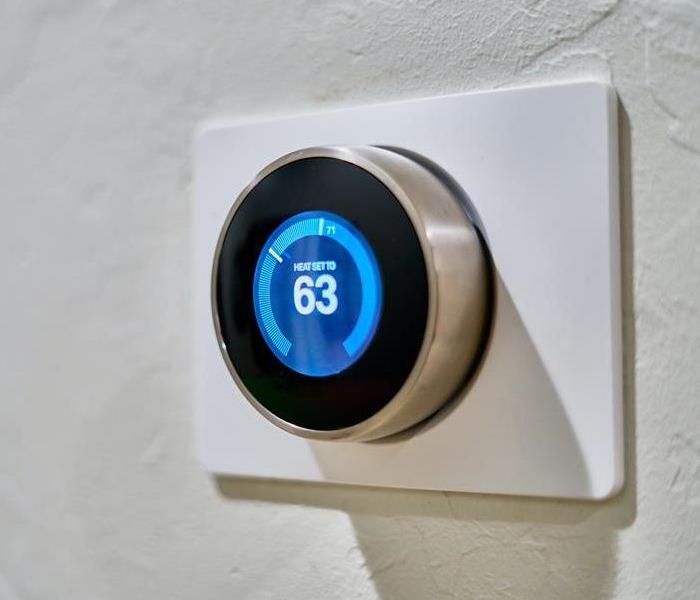 During the summer months, your home or business is kept cool by your HVAC unit, but did you know that they can present fire hazards?
During the summer months, your home or business is kept cool by your HVAC unit, but did you know that they can present fire hazards?
During the summer months, your home or business is kept cool by your heating, ventilation, and air conditioning unit. All the while, your HVAC unit can pose fire hazards if they aren’t properly maintained. Because HVAC fires can cause devastating damage, it is crucial that your HVAC unit is inspected and professionally serviced on a regular basis. We’ll introduce you to three common causes of HVAC fires in this blog. With a deeper understanding of how HVAC fires ignite, you can be proactive and protect your home or business from a fire emergency as a result of your HVAC unit malfunctioning this summer.
Overheated Motor
If your HVAC unit’s motor starts overworking, it can overheat and catch fire. Your HVAC unit’s motor can overheat for a variety of reasons. For example, dirt or debris occupying the space surrounding the unit’s motor can serve as an insulator, which causes the motor to overheat. You can prevent a fire from igniting as a result of your HVAC motor overworking by ensuring that your HVAC unit is regularly cleaned. Your unit’s motor can also overheat if there is either an abundance or shortage of voltage applied to power the motor.
Electrical Issues
It is possible that your HVAC unit may catch fire as a result of faulty wiring or electrical issues. Usually, electrical connections naturally loosen over time. Sometimes, if corroded or frayed wires are not replaced or repaired quickly, they can cause electrical shorts and this can cause fires to ignite. In order to avoid electrical complications, schedule regular HVAC unit inspections and ensure that wires are replaced when necessary.
Leaking Fuel Line
Leaking fuel lines can lead to gas leaks in your home or business. A fire can ignite if the leaking gas comes into contact with heat. In the event that you smell gas in your home or business, especially if the smell appears to be emanating from your HVAC unit, it is critical to treat the situation seriously.
We Are HVAC Professionals
Our SERVPRO Disaster Recovery Team - Team Wall team members are knowledgeable and experienced HVAC professionals. You can trust us to thoroughly inspect and service your home or business’ HVAC unit. Homeowners and business owners are recommended to schedule biannual HVAC unit inspections in order to most effectively maintain the unit and prevent fires. Learn more about our HVAC Cleaning, Cleaning Services, and Fire Damage Restoration services in case of an emergency, check out their respective pages on our website. You can also call your local SERVPRO Team Wall office, SERVPRO of Metro Pittsburgh East, at (412) 672-5400.
Getting Rid of That Smoke Smell After a Fire
3/24/2022 (Permalink)
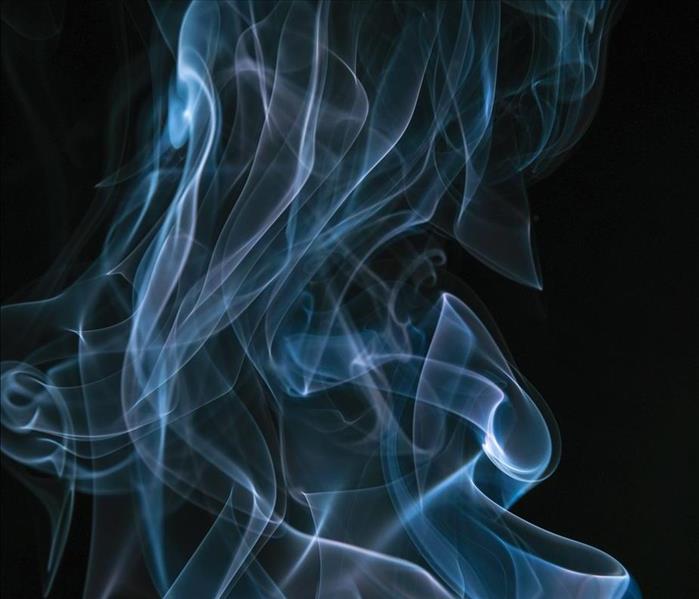 Smoke can linger on surfaces long after the actual fire is extinguished.
Smoke can linger on surfaces long after the actual fire is extinguished.
We all know the smell. Even if your only experience with fire smell is sitting around a campfire for an hour or so, you know that the smoke smell accompanies your clothes all the way back inside. This is a great example of the way in which smoke can linger on surfaces long after the fire is extinguished. While professional assistance is often necessary in order to completely eradicate the odor after a large fire, there are a few things that you can do to facilitate the deodorization process while you wait for help to arrive:
3 Steps You Can Take to Decrease Odors After a Fire
A quick and easy way to increase airflow and circulation after a fire is propping open windows, as well as doors if it is safe to do so. Removing and replacing air filters can also be helpful in preventing smoke particles from spreading further from the initial affected area. A third option is deep cleaning surfaces in the affected area. Beyond scrubbing counters and hard surfaces, it is also important to clean other types of surfaces. Think back to the smell lingering on your clothes after sitting by a campfire. Smoke particles can stick to fabric surfaces like curtains, carpets, and blankets. Additionally, windows are also affected and should be targeted in a deep clean. So, when deep cleaning after a fire, be sure to give attention to countertops, windows, and fabric surfaces alike.
SERVPRO Is Here to Help
Again, expert, professional help is the only way to ensure that your property’s smoke smell is thoroughly eliminated. The 3 aforementioned steps are offered simply as ways in which you can improve living or working conditions before help arrives. Here at SERVPRO, we minimize the amount of time you have to wait for help to arrive, as we offer 24-Hour Emergency Services. Our Odor Removal services are backed by a team of highly-trained deodorization professionals in addition to advanced equipment and techniques. In the event that your residential or commercial property endures a fire, call SERVPRO Disaster Recovery Team - Team Wall right away at (412) 672-5400. To learn more about how we make it “Like it never even happened,” for our customers after any emergency, take a peek at the rest of our website. Here, you’ll be able to read more about the long list of other restoration, construction, and cleaning services that we provide, including Fire Damage Restoration, Commercial Fire Damage Restoration, and Fire-Damaged Contents Care services. Trust SERVPRO to quickly and efficiently restore your property to its preloss condition.
Kitchen Cooking Safety: 3 Tips
3/4/2022 (Permalink)
 Protect your kitchen and the rest of your home from the destructive nature of fire damage by educating yourself on kitchen fire safety best practices.
Protect your kitchen and the rest of your home from the destructive nature of fire damage by educating yourself on kitchen fire safety best practices.
“The leading cause of fires in the kitchen is unattended cooking,” according to the National Fire Protection Agency. They also report that the appliance most commonly involved in kitchen fires is your stovetop, but kitchen fires can stem from a variety of sources if improperly monitored. Altogether eliminating the possibility of an unwanted fire igniting is virtually impossible, but you can best protect your kitchen and the rest of your home from the destructive nature of fire damage by educating yourself on kitchen fire safety best practices. Continue reading to learn more about 3 of the NFPA’s cooking fire safety tips.
- Don’t Stray Too Far from the Kitchen
There are different recommendations based on what kind of cooking activity you are conducting in the kitchen. Stovetop activities, such as frying, boiling, broiling, and grilling, require you to stay in the kitchen for the entire process so that you can monitor the area and take action immediately if a fire ignites. If a situation arises that requires you to leave the kitchen for any amount of time, it is strongly advised that you turn the stove off completely. Contrastingly, cooking activities that require more cooking time, including roasting, baking, and simmering, may be safe to leave the kitchen, but only for short periods of time. If you must leave the kitchen, it is a good idea to regularly check in and set a timer in order to decrease the risk of fire.
- Know What to Do When an Oven Fire Occurs
We’ve discussed what to do in the event of a stovetop fire, but what is the best course of action for dealing with an oven fire? Suppose something that you’re baking catches fire in your oven. The NFPA suggests that you turn the heat off as soon as possible and do not open the oven door until the fire is extinguished. Opening the door may facilitate the spread of the fire. If the fire does not go out on its own, call 911 immediately.
- Keep Your Cooking Area Clear of Flammable Objects
All around your cooking area, you may possibly find a wide variety of flammable objects that are not necessarily out of place. By an oven, there are usually oven mitts, which are flammable, as well as towels and wooden utensils. These are all helpful tools when cooking, but they can also facilitate the quick spread of an unwanted fire in the event that one ignites. In order to prevent any unwanted fires from spreading, it is beneficial to keep flammable kitchen objects and tools tucked away, stored in cabinets or drawers when not in use.
Experienced a Fire? Call SERVPRO
No matter what kind of fire your home or business may experience, know that SERVPRO of Metro Pittsburgh East is just a call away. If your property sustains fire damage to any degree, call us at (412) 672-5400 for immediate assistance. Here at SERVPRO, we are committed to making your property damage “Like it never even happened.” By visiting our website, you can also learn more about our Fire Damage Restoration services, tailored to both residential and commercial properties in order to best meet your needs. Additionally, you can find more information about our other fire-related cleaning services, including Odor Removal and Deodorization. Be sure to also check out our best Fire Damage Tips.
Home Fire Safety: Fire Extinguishers
12/10/2021 (Permalink)
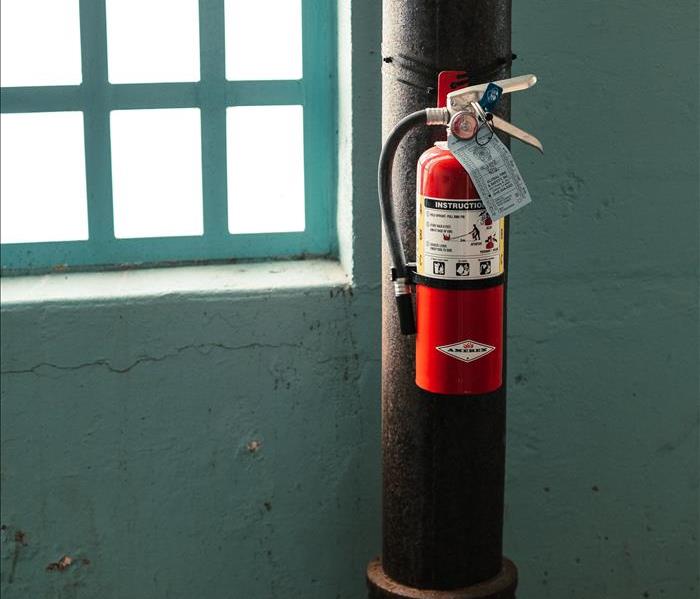 Residential properties, including houses, apartments, and condos, can benefit from having a fire extinguisher on hand.
Residential properties, including houses, apartments, and condos, can benefit from having a fire extinguisher on hand.
When you think of properties with fire extinguishers on the premises, public buildings like libraries and restaurants or stores usually come to mind, right? It may come as a surprise to learn that residential properties, including houses, apartments, and condos, can also benefit from having a fire extinguisher. In this blog, we’ll break down for you three of the most common classifications of fire extinguishers for residential use so that you can make an informed decision in the event that you decide to purchase a fire extinguisher for your home.
- Class A Fire Extinguishers
Class A fire extinguishers tackle fires catalyzed by household objects like paper, wood, and fabric. If purchased, it may be beneficial to store a Class A fire extinguisher near a fireplace or in common spaces like the living room.
- Class B Fire Extinguishers
In workshops, garages, and sheds containing combustible liquids like gasoline, grease, or propane, Class B fire extinguishers are your best bet.
- Class C Fire Extinguishers
Small electrical fires can be extinguished with the help of Class C fire extinguishers. Any kind of complication involving electrical equipment, from electrical appliances to electrical tools, can initiate electrical fires. If purchasing a Class C fire extinguisher, some beneficial places to store them include the kitchen as well as workshops or garages containing power tools.
Multipurpose Fire Extinguishers
At this point, you may realize that all three classes of fire extinguishers could meet your home’s fire protection needs. Does this mean that you should purchase one of all three fire extinguisher classifications? No- there is a better alternative. Instead, you can purchase a multipurpose fire extinguisher, which combines multiple classifications and can typically be purchased in hardware stores. An ABC fire extinguisher, therefore, can be used to put out all three fire classifications. Due to their versatility and usefulness in many different situations, National Fire Protection Agency recommends multipurpose fire extinguishers for homeowners.
Fire Damage? Call SERVPRO
Fire extinguishers- by no means- are an effective line of defense against every fire. Rather, fire extinguishers should be utilized when fires are in their very early stages or are extremely small and containable. When a large fire ignites, it is critical to focus on getting your loved ones out and calling 911. No matter the severity of the repercussions, know that SERVPRO Disaster Recovery Team - Team Wall’s professional Fire Damage Restoration services and sincere care for your fire damaged belongings will help restore your home to its preloss condition as best as possible. As soon as the fire is extinguished, pick up the phone and call SERVPRO of Metro Pittsburgh East, your local SERVPRO Team Wall office, at (412) 672-5400. We offer 24-Hour Emergency Services, which ensure that our experienced crew will arrive on site as fast as possible. Learn more about our Commercial Fire Damage Restoration services, designed specifically to meet the needs of commercial properties and our Odor Removal and Deodorization services, which can be helpful in the final stages of restoring your home. Regardless of whether or not your home is equipped with a fire extinguisher, there is always a possibility that an unexpected fire could ignite, but remember that SERVPRO Team Wall is just one call away, ready to help in any way possible.
Fireplace Fire Safety
12/3/2021 (Permalink)
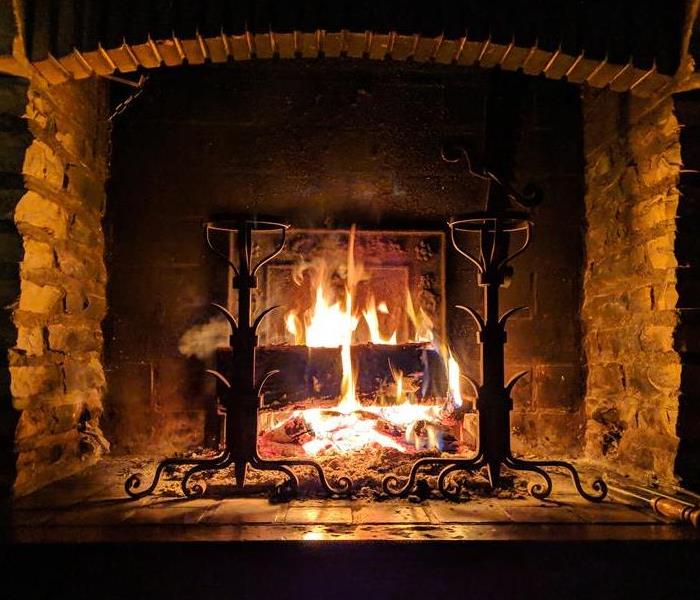 “1 of every 6 home fires,” according to the American Red Cross, is the result of heating equipment, including fireplaces.
“1 of every 6 home fires,” according to the American Red Cross, is the result of heating equipment, including fireplaces.
Winter and its chilly temperatures bring ample opportunities for us to put our fireplaces to use. While effective in heating our homes, fireplaces can also present fire hazards for your home. With a thorough understanding of fireplace fire hazard statistics and preventative measures against dangerous fires resulting from fireplace mishaps, you can protect your home from devastating and unexpected fire damage this winter.
Overview of Fireplace Statistics
“1 of every 6 home fires,” according to the American Red Cross, is the result of heating equipment, including fireplaces. They also assert that from December to February, the height of winter in the United States, “1 in every 5 home fire deaths and half of all fires caused by home heating” take place. But what exactly is it that causes such devastating consequences to homes and those living in them? “The leading factor to home heating fires,” according to the Environmental Protection Agency and the National Fire Protection Agency, “was failure to clean, principally creosote from solid-fueled heating equipment, primarily chimneys.” In fact, fireplace complications account for 87% of heating equipment fires in residential buildings, according to the EPA. Clearly, fire safety must be exercised in homes when interacting with fireplaces in order to minimize consequences.
“So, What Can I Do?”: Chimney Fire Prevention
We’ll cover a few preventative measures that you can take as a homeowner in order to decrease the likelihood of a fire igniting as the result of a fireplace fire. Flammable household items, such as clothing, newspaper, and, especially during the holidays, wrapping paper, are all considered “fuel” for chimney fires, according to the Red Cross. These items should always remain at least 3 feet away from your fireplace. Utilizing a fire screen is another way to make sure that embers, sparks, and other elements of your fireplace fires do not readily escape your fireplace or make their way towards flammable objects within the room. Once finished with your fireplace fire, be sure to extinguish the fire thoroughly, leaving no possibility for it to reignite while unattended. Once per year, according to the Red Cross, it may also be helpful to enlist the help of a fireplace expert in checking and cleaning your home’s fireplace. Lastly, consider installing smoke and carbon monoxide detectors throughout your home and keep a fire extinguisher handy in the event of an emergency.
What To Do If Your Fireplace Instigates a Fire
It is somewhat rare for a fireplace fire to escape the chimney and cause objects in the room to catch fire, but as we have seen through the statistics shared at the beginning of this blog article, it can happen and, when it does, the consequences can be catastrophic. In the event that the unexpected comes to fruition, give SERVPRO Disaster Recovery Team - Team Wall a call. You can contact our local SERVPRO of Metro Pittsburgh East office at (412) 672-5400 in order to speak directly with one of our team members. Our team of fire damage specialists has seen it all and is always prepared to tackle any size or type of fire emergency. We will restore your home to its preloss condition through our acclaimed Fire Damage Restoration services, as well as our Water Damage Restoration services, which can be helpful in cleaning up when hoses and water are utilized to extinguish the fire. Fires can also leave behind cosmetic damage and unpleasant odors, both of which we combat with our Cleaning services and Odor Removal service. On our website, you’ll also find a few of our favorite Fire Damage Tips, which provide information concerning what to do before our crews arrive on the scene. No matter what happens this winter, know that SERVPRO Disaster Recovery Team - Team Wall is always standing by, ready to help.
Warehouse Fire: Job of the Quarter
10/8/2021 (Permalink)
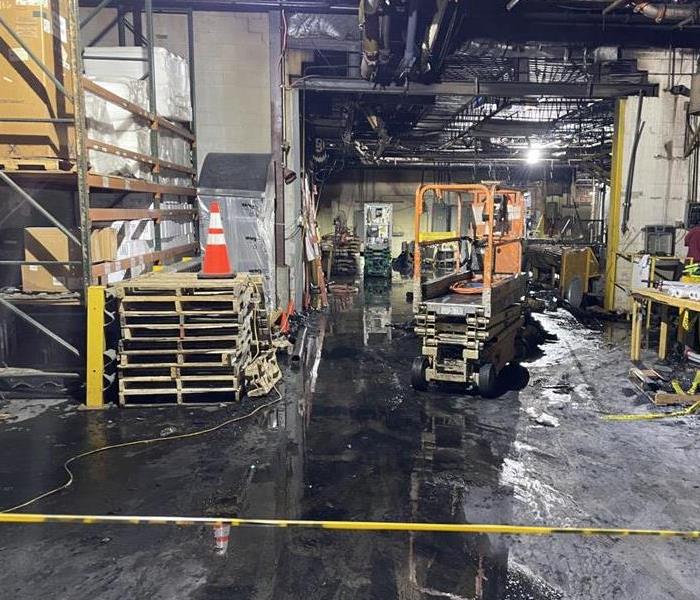 Approximately 170,000 square feet of warehouse space had been impacted by smoke and soot.
Approximately 170,000 square feet of warehouse space had been impacted by smoke and soot.
Not a quarter goes by that we don’t stop and take a moment to recognize a specific job that exemplifies who we are and what we do here at SERVPRO Disaster Recovery Team - Team Wall. For this quarter’s “Job of the Quarter,” we would like to highlight our large loss fire damage restoration work with that we completed this past July. What made this a stand-out job was the cooperation of team members from every division of our company, which enabled us to complete the job quickly and efficiently, getting our customer back into their warehouse as soon as possible.
A Large Loss Is Never Too Large
On June 28th, a call came through to our office notifying us of a large warehouse fire located on a commercial property. Within 24 hours of that initial call, our Harrisburg West team members arrived on the site in order to complete a damage assessment. We were able to convince our potential customer that SERVPRO Team Wall was the right fit for the job thanks to our 24-Hour Emergency Services, advanced technology such as Matterport, and our extensive experience with large loss commercial restoration and reconstruction work alike.
Making It “Like it never even happened.”
These types of jobs are labeled “large loss” due to the significant amount of damage that they leave behind and the aftermath of the fire damage inside the warehouse was no exception. Approximately 170,000 square feet of warehouse space had been impacted by smoke and soot. Because of the fire’s proximity to the warehouse’s HVAC unit, the spread of the smoke and soot was even more profound. Our mission in any job is to make it “Like it never even happened,” so we got to work right away by tarping the roof and cleaning ducts on the same day that the contract was signed. Additionally, we committed to working through the 4th of July weekend, which allowed us to clean offices while employees were not working and reduce distractions. Business could not stop for our customer, so our team was faced with the challenge of sectioning off work areas and coordinating schedules in order to cause the least amount of disruption to their daily operations as possible. Every day, we had at least 40 crew members working morning, noon, and night. To restore the warehouse to its preloss condition, we also rented a scissor lift in order to clean the high ceilings, which had also been impacted by the fire. By July 26th, the warehouse was ready for the final walkthrough, which meant that we had completed the entire project in just 22 days.
Teamwork Makes All The Difference
We complete many jobs each quarter that showcase the kind of company that we are and what we strive to achieve with every job, but what made this specific work especially worthy of the “Job of the Quarter” title was our company-wide commitment to teamwork that enabled the job to run smoothly. Our digital marketing made the opportunity possible through advertising. Our sales team and specifically commercial account manager Jannene Miller kept the customer up to date throughout the entire process. Owner Jim Wall, Harrisburg West Vice President of Operations Jason Quick, and Large Loss Production Manager George Readinger, also developed a personal connection with the customer by visiting the job site. Letters of recommendation were sent from the office thanks to the help of our other owner, Trish Wall. With such a large job, we would not have been as successful as we were if members from every aspect of our company had not pitched in where they could. Our strong sense of team cooperation also helped us make certain that our customer was happy at every point throughout the restoration process.
Have a Large Loss? Call Team Wall
Large losses can be overwhelming due to their size and the disruption they impose upon commercial businesses' daily operations. In the event that your commercial business falls victim to a large loss of any variety, you can take comfort in the fact that SERVPRO Disaster Recovery Team - Team Wall is always ready to help make it “Like it never even happened.” Our team of professional commercial restoration experts and our advanced technology are standing by to deliver our fire, water, storm, and mold damage restoration services that are specifically designed for commercial properties. It was a pleasure to help Henry Molded Products get back up on their feet after their facility’s large fire loss. We hope that your commercial business’ property will never endure a large loss, but SERVPRO Team Wall is just a call away and always ready to help in the event of an emergency.
After The Fire: Cleaning Your HVAC Unit
9/2/2021 (Permalink)
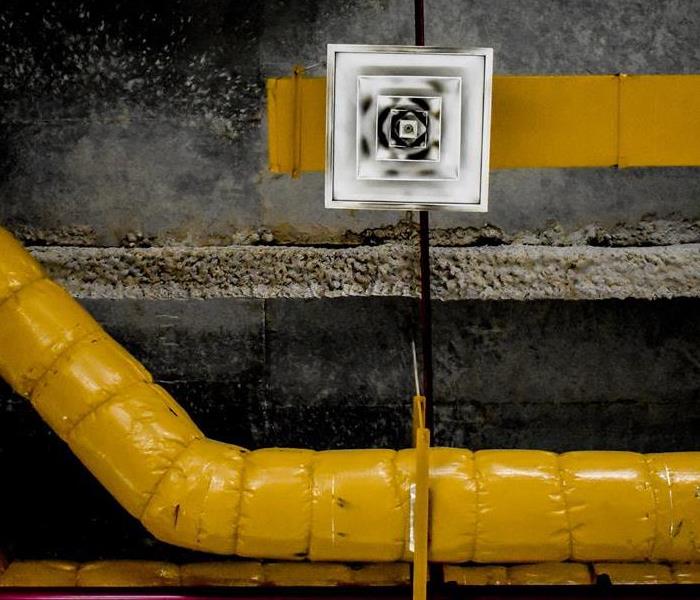 After a fire of any size, our Fire Damage Restoration and Air Ducts and HVAC Cleaning services are just what your property needs to recover.
After a fire of any size, our Fire Damage Restoration and Air Ducts and HVAC Cleaning services are just what your property needs to recover.
A fire emergency alone is stressful, but the resulting damage to your residential or commercial property can cause even more of a headache. When looking to implement fire damage restoration services, it is important to address damage to structure and personal belongings or contents as well as behind-the-scenes components of your home or business. One such component is your property’s HVAC system, which can exacerbate fire damage if it is not properly cleaned after a fire. Facilitating the flow of air throughout your property, HVAC units can pick up smoke and soot residue from fires and transport it to other locations in your business or home, which increases human health effects. Wondering what SERVPRO can do to help after a fire of any size? Our Fire Damage Restoration and Air Ducts and HVAC Cleaning services are just what your property needs to make a full recovery.
When Should HVAC Cleaning Be Implemented?
Fires that are moderate to heavy in terms of severity often produce the highest amounts of smoke and soot residue and therefore, these types of fires frequently require HVAC cleaning. Another factor to consider when determining whether HVAC cleaning is necessary is the proximity of the fire to your property’s HVAC unit. It is beneficial to contact a professional specializing in fire damage and HVAC cleaning who can provide a reliable assessment of your property’s unique damage situation and its subsequent needs. By calling SERVPRO of Metro Pittsburgh East, both fire damage restoration experts and HVAC cleaning specialists will work to ensure that your home or business receives the help that it needs.
HVAC Cleaning Reduces Health Effects
While fires cause visible damage to personal belongings and the structures of properties, they can also create invisible dangerous health effects to which people living or working in the affected home or business can be exposed. HVAC cleaning after a fire minimizes these risks and helps protect individuals from serious health effects and reactions to poor air quality.
For Professional HVAC Cleaning, Call SERVPRO
SERVPRO of Metro Pittsburgh East is here to help in the event that your residential or commercial property endures damage in the wake of a fire. At the first sight of fire damage, call us immediately at (412) 672-5400 for trustworthy fire damage restoration services implementing top-of-the-line equipment. We also offer a variety of specialized Cleaning Services in addition to Air Ducts and HVAC Cleaning, including Odor Removal, and Carpet & Upholstery Cleaning, which can help make your property’s fire damage “Like it never even happened.” For a comprehensive restoration that checks every box and prevents your property from enduring any additional damage after any fire, look no further than SERVPRO.
Practicing Fire Safety With Lithium Batteries
8/13/2021 (Permalink)
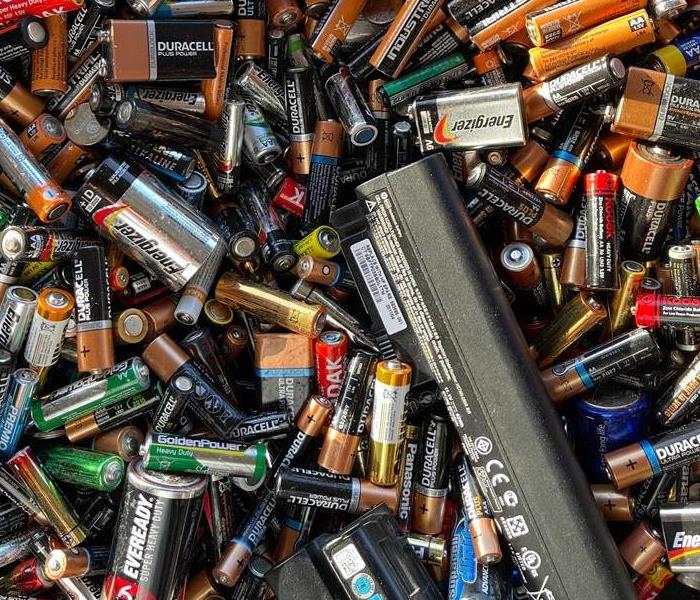 It is important to understand that lithium is a powerful substance that can create fire hazards in certain circumstances.
It is important to understand that lithium is a powerful substance that can create fire hazards in certain circumstances.
Lithium might ring a bell as one of the elements included on the periodic table or maybe even as the title of a classic Nirvana song. In terms of electricity, lithium tackles multiple different roles, including the power source for lithium batteries and lithium-ion batteries alike. The two different types of lithium batteries differ in their cell type and abilities to recharge, but they both allow electronic devices to run on portable energy. As a result, many of the electronic devices that we use on a daily basis employ lithium batteries. All the while, it is important to understand that lithium is a powerful substance that can create fire hazards in certain circumstances. Keep reading in order to learn more about the steps that you can take to prevent fire damage caused by lithium batteries in your residential or commercial building.
Why Are Lithium Batteries Such a Concern?
While risks accompany lithium batteries, they are still safe for everyday use. Unless they short-circuit or overheat to a certain degree, both of which are rare occurrences, lithium batteries can be used safely on a regular basis. However, overheating and overcharging can both cause electronic devices to release a significant amount of heat, increasing the risk of fire. You may have seen recent news stories about cell phones and hoverboards going up in flames on hot days, but these circumstances are extraordinarily rare. As a matter of fact, the United States Postal Service categorizes lithium batteries as Class 9 hazards, a category consisting of miscellaneous hazardous materials that are only dangerous in transit situations.
Preventing Lithium Battery Fires This Summer
In our everyday lives, lithium batteries and lithium-ion batteries play important roles by powering devices of all kinds, from electric toothbrushes to cell phones and laptops. During the summer season, the risk of fires resulting from overheating increases under the scorching summer sun. You can protect your residential or commercial property from an unwanted lithium battery fire this summer by adhering to fire safety procedures. One preventative measure is making sure that electronic devices are not left lying idle in hot environments such as hot cars or under the sun for prolonged periods of time. Additionally, it is a good idea to avoid charging electronic devices in hot environments. Charging your devices can be made safer by avoiding overcharging and utilizing a high-quality charger. It may also be helpful to purchase a strong case for your device that will effectively protect its battery from potential damage.
Have You Experienced Fire Damage? Call SERVPRO
Even if preventative measures are put in place, it is still possible for the unimaginable to happen. That’s why SERVPRO of Metro Pittsburgh East is “Ready For Whatever Happens” and always standing by in the event that an emergency occurs. Whether it’s a lithium battery or a different catalyst that causes a fire to ignite and cause damage to your property, SERVPRO can help. As a leading name in the fire damage restoration industry, we offer top-of-the-line Commercial Fire Damage Restoration Services and Fire Damage Restoration Services for residential properties. For immediate services and the best chance of preventing any further fire damage, call SERVPRO of Metro Pittsburgh East right away at (412) 672-5400. You can learn more about our Fire Restoration Process and other fire-related services, such as how we care for your fire damaged belongings by visiting our website. Trust SERVPRO and our 24-Hour Emergency Services to help you restore your residential or commercial property to its preloss condition in the event of a fire.
All About Matterport
6/25/2021 (Permalink)
In a wide array of industry sectors, Matterport is known as the premiere technology for capturing 3D spaces, leading the way in digitizing and indexing the built world with spatial data. An exact, digital copy of any physical space can be created with the help of Matterport’s 3D platform, which promotes a more holistic understanding of the space. This leads to better building, design, operation, and promotion of physical spaces.
How Does Matterport Help Our Clients?
When it comes to Matterport technology, industry insurance professionals and our customers especially benefit from two specific aspects, which are accuracy and velocity. The days of using our hands and camera phones to document property damage are long gone. Matterport simplifies the process, detailing damage through digital measurements and photographs, as well as reducing human error so that that margin of error is limited to only 1%. As a result, there is no room for bias due to the objective 3D spatial data generated by Matterport technology. In this way, the claim settlement process is facilitated, which gets work started faster and ultimately helps customers return to normalcy as soon as possible.
Matterport In Action
Overcoming Pandemic Obstacles
Insurance companies and field adjusters came face-to-face with obstacles resulting from the COVID-19 pandemic, as many adjusters could not set foot on properties. Therefore, adjusters had to turn to other tools and methods in order to push through and continue their work. SERVPRO Disaster Recovery Team- Team Wall’s partnership with Matterport in conjunction with our unparalleled services offered to mutual customers set their minds at ease.
Faster to the Finish Line
The roof of a multi-family condominium experienced structural damage, which led to an engineer arriving onsite to inspect the damage and determine which repairs needed to be made. He was pleasantly surprised to find that an in-depth, 3D scan of the property had already been completed by SERVPRO Disaster Recovery Team- Team Wall utilizing Matterport technology. This step made his job easier, as he was able to complete his report quickly, which in turn enabled our team to get to work faster. By minimizing the amount of time spent assessing the property damage, we were able to reduce the total turnaround time, making it “Like it never even happened.”
Caring for Your Belongings
After receiving a call about a residential fire, the task of documenting the total amount of damage to structure and personal belongings rested in the hands of Matterport. The health of our client limited the amount of time that she could spend on the job site, but thanks to Matterport’s digital scans of the property, she could stay in the loop with the restoration process and even lend a hand in documenting items that could not be salvaged.
SERVPRO and Matterport Are Here To Help
Superior customer service takes centerstage here at SERVPRO Disaster Recovery Team- Team Wall. In order to improve the restoration services that we provide to both residential and commercial properties, we work in conjunction with advanced technologies, such as Matterport. Give us a call at (412) 672-5400 to learn more about our relationship with Matterport and the various services that we provide at SERVPRO of Metro Pittsburgh East. For additional information about our restoration services, visit our website’s pages dedicated to storm, fire, water, and mold services, as well as our Advanced Technologies like Matterport. In the event that your home or business experiences an emergency of any kind, know that SERVPRO of Metro Pittsburgh East, as well as Matterport, are standing by and are prepared to help.
Understanding Guidelines: Practicing Electrical Fire Safety
5/12/2021 (Permalink)
We’ve all been there. We’re grasping a device whose battery is on the brink of running out in one hand and a plug in the other, staring at an outlet and wondering, “Would it be safe to plug this in here?” It may be surprising to learn what kind of damage just one extra plug can do when an outlet becomes overloaded. The guidelines for electrical outlets are a bit fuzzy, which makes electrical fire safety difficult. The National Fire Protection Agency reports that from 2012 to 2016, electrical conundrums were the second most common cause for the ignition of electrical fires in homes. Therefore, it is crucial that we get to the bottom of the electrical outlet guideline debacle and understand how to best protect our homes against electrical fires.
Statistics About Electrical Fires
First, we must become aware of the most frequent instigators of residential electrical fires. FEMA published a report on Residential Building Electrical Fires in 2018, which discovered that between the years of 2014 and 2016, electrical fires served as the catalyst of most electrical fires occurring in homes. It is also important to note that receptacles and outlets were the source of 12 percent of such fires. 5 percent of electrical fires also emanated from extension cords. With this information in mind, be sure to exercise caution when handling electrical wires, cords, and outlets.
Guidelines
Outlined in the FEMA report are a large number of guidelines that relate to fire safety practices when encountering appliances, outlets, and extension cords.
Appliances
Appliances like microwaves, washing machines, and refrigerators, according to FEMA, must always be directly plugged into wall outlets. Keep an eye out for signs of damage on appliances’ wires and cords. Loosening and cracking can often lead to malfunctions and, ultimately, electrical fires.
Outlets and Extension Cords
Because they provide a quick and easy solution to the issue of having a greater ratio of cords to wall outlets, it can be tempting to overload extension cords. When extension cords are overwhelmed, however, there can be an increased risk for the ignition of an electrical fire. Usually, you can find an extension cord’s maximum capacity detailed on its packaging and be sure to never overload extension cords with more than they can handle. Internal overload protection is an important characteristic to consider when deciding what kind of extension cord to utilize. It is equally important to avoid overwhelming wall outlets with too many plugs. Be sure that you do not force three-pronged plugs into outlets that are designed for two-pronged plugs.
Where SERVPRO Can Help
We can take preventative measures to protect our homes against electrical fires, but accidents can still happen. That’s why we here at SERVPRO of Metro Pittsburgh East, we provide 24/7 Emergency Services and professional Fire Damage Restoration Services that will help you make an electrical fire “Like it never even happened.” For more information about the fire services that we provide, be sure to check out our website, which includes everything from a detailed explanation of our Fire Restoration Process to our expert Fire Damage Tips. For immediate help, call us at (412) 672-5400 and let us handle the rest.
Why Is Demolition a Necessary Treatment for Smoke Damage?
3/29/2021 (Permalink)
There’s no questioning the destructive nature of fires in both homes and businesses. All the while, we often forget fire’s often invisible accomplice, smoke, which can do just as much damage. Even though we may not be able to see the effects of smoke damage, it is important to understand that smoke is an invasive substance that merits more restoration efforts than what initially meets the eye. By learning more about smoke’s invasive nature, you can better understand the dangers it poses to homes and commercial business.
Why Is Smoke Invasive?
Seeping into cracks and crevices, smoke has many hiding places. For that reason, attempts at cleaning surfaces will only cause soot particles to smear. The porous quality of drywall also makes for another place in which smoke can hide. When smoke makes its way into drywall, it can also infiltrate insulation, which often results in a need for demolition work in order to eradicate smoke odor in the affected areas. Based on the nature of the affected contents, as well as their proximity to the fire’s source, the intensity of smoke damage may vary.
Surprising Effects of Smoke Damage
After a fire, you may discover shapes resembling spider webs on the walls and ceilings of your home or commercial business. These are not spider webs, but smoke and soot residue left behind by the fire. In this case, smoke damage is visible. However, this is not always the case. For example, the aftermath of protein fires is characteristically invisible, as they do not leave a trail of smoke or soot. This does not mean that they do not leave behind damage. Instead, there is still a lingering smoke odor and soot, which is acidic, can corrode metal objects over time, risking long-term damage.
Why Is Demolition Necessary?
While smoke damage is sometimes invisible, it is important to consider that areas of homes or commercial businesses that have endured smoke damage may still require demolition for a thorough restoration. Demolition work is frequently necessary because scrubbing surfaces does not combat the hidden aspects of smoke damage. Smoke, soot, and smoke odor often take refuge in small cracks and crevices. Additionally, these substances can also sneak into the gaps separating drywall and interior firewalls in homes and businesses. Specifically, smoke odor may infiltrate insulation and hot, humid weather can cause the smell to re-emerge. Scrubbing only scratches at the surface of the much larger issue of invasive smoke damage.
How Do We Combat Invasive Smoke Damage at SERVPRO?
As soon as we arrive onsite at the scene of the fire, we immediately get to work removing charred or burned materials. Additionally, we “chase” the smoke through open areas in an effort to identify every room of the home or business to which the smoke has spread. In this way, we can take thorough inventory of every area requiring smoke damage restoration services. Because water frequently accompanies smoke damage, we also prioritize extracting water and drying the affected area. Continuing the restoration process, we utilize our specialized equipment in order to eliminate the smoke odor. The final step of our process involves sealing off small, difficult-to-reach cracks and crevices that contain lingering smoke odor, using a sealant.
Trust SERVPRO with Smoke Damage
If your home or business has endured a fire that has resulted in smoke damage, be sure to call SERVPRO of Metro Pittsburgh East right away at (412) 672-5400. Our 24/7 Emergency Services can guarantee that your smoke damage will be addressed immediately in order to reduce the spread and invasion of smoke. Our professional team or smoke damage specialists will arrive onsite quickly and get to work combating the issue, using our tried and trusted restoration techniques. From deodorizing affected areas to cleaning contents, we are capable of handling the entire job from start to finish. This means that, in addition to our renowned Fire Damage Restoration Services, we also offer our customers Building Services that range from drywall installation and roofing services to painting and hardwood floor repair. You can trust SERVPRO to have you covered throughout the restoration, demolition, and rebuild processes.
Restoring Fire Damaged Curtains
3/3/2021 (Permalink)
The structure of both homes and commercial buildings, as well as the objects and belongings that they house, are put at serious risk during a fire. Therefore, it is pertinent that actions are taken to prevent fire damage and, in the event that a fire ignites, the cleanup process is initiated as soon as possible. When it comes to the cleanup process, it is likely that you’ve seen guides detailing methods of cleaning fire-damaged surfaces. You’re more unlikely to find those explaining how to clean fire-damaged textiles and fabrics, such as curtains and draperies, which are extremely flammable and therefore more susceptible to damage during a fire. You may be wondering: What should I do if I discover that my curtains have been damaged in a fire? On the bright side, you don’t need to immediately rush them to the garbage. They will likely require a bit of cleaning, but they can be salvaged. Keep reading to learn how to take care of your fire damaged curtains.
How to Care for Fire-Damaged Curtains
The destruction of a fire can leave behind two different varieties of fire damage, which include soot damage and smoke damage. It is possible that your curtains endured either one or both of these types of damage during the fire. Before the cleaning process begins, it is important to understand that each requires its own, specific cleaning procedure.
Soot Damage
When curtains are inflicted with soot damage, particles of soot, which are oil-based, infiltrate the fabric of the curtains. If these soot particles are not removed quickly, your curtains can become stained and undergo significant damage that is difficult to remove. Once the soot particles are gone, the cleaning process can begin. While you have a multitude of cleaning options, know that SERVPRO provides drapery cleaning services that can effectively cleanse your curtains of any remaining fire damage and, with the help of our specialized equipment, restore them to their preloss condition.
Smoke Damage
Like soot damage, immediate action is also necessary when it comes to smoke damage, as eliminating the odor that accompanies smoke takes precedence over all other steps of the cleaning process. Over time, the smoke odor can embed itself into the fabric and cause additional damage. For a quick and efficient smoke odor removal, look no further than SERVPRO. Your curtains can be salvaged with our trustworthy odor removal and deodorization treatments. Don’t forget that we also offer professional Drapes and Blinds Services that can handle the rest of the cleaning process for your curtains following the smoke odor removal.
Preventing Additional Fire Damage
In order to avoid additional fire damage during the cleanup process, be sure to be aware of actions of occurrences that could put your home or business at an increased risk. Touching fire damaged curtains without gloves is not advised. It is also important to acknowledge that curtains can oftentimes become saturated with water during the fire extinguishing process, which increases the threat of mold growth. However, you can reduce this risk by making sure that wet curtains are dried as soon as possible. Another beneficial, preventative measure is facilitating air circulation in your home or business, which can be achieved by opening windows. Additionally, if you are on the market to purchase new curtains, take into consideration the idea of investing in fire-resistant curtains, which may prove helpful in decreasing the chances that your curtains sustain damage during a future fire. It is crucial to never underestimate the importance of fire safety. Be sure to practice fire safety in your home or business and regularly replace the batteries in your smoke detectors.
Got Fire Damage? Protect Your Belongings with SERVPRO
SERVPRO of Metro Pittsburgh East is standing by in the event that your home or commercial business is impacted by a fire. We offer an array of fire damage restoration services as well as contents restoration services that will help your home or business and its contents make a full recovery after a destructive fire. For professional restoration services that will protect your curtains and other belongings, call SERVPRO of Metro Pittsburgh East at (717) 510-6779 today. To learn more about our services, visit our Your Belongings and Fire Damage page.
What Do I Do After A House Fire: Moving Forward
2/2/2021 (Permalink)
When a fire ignites in your home, your home and your personal belongings are placed in jeopardy. Fires can leave a path of destruction, complete with soot and smoke damage. In addition to the physical damage, a fire can alter and change your life as you know it, leaving you ready to do whatever you can in order to return things to normal. Before taking action to combat fire damage in your home, it is important to understand that just one wrong move can exacerbate the damage. There are two crucial pieces when confronting fire damage in your home: mitigating the damage and preventing future fires. For several of our expert Fire Damage Tips and steps that you can take to protect your home from future fires, keep reading.
Fire Damage Restoration Tips
With our many years of experience in mitigating fire damage and cleaning smoke damage, we have compiled a list of Fire Damage Tips. The following may be helpful in understanding the safest ways of dealing with your home’s fire damage:
- Decrease Movement
Even the act of placing your foot down on the floor can cause fire soot particles to jump up into the air and land on nearby objects, therefore imposing further damage. In order to best protect your home’s furniture, upholstery, carpets, and other objects from unnecessary damage, refrain from walking throughout your home as best you can and if you must move, be sure to exercise caution.
- Don’t Attempt to Clean Without Professional Guidance
More harm than good can come from unguided efforts to clean fire-damaged items and surfaces in your home. Rather, consult skilled fire damage cleaners prior to taking any actions to clean damaged objects. It is also wise to steer clear of any electronic devices or appliances in your home, as coming into contact with them after they have been exposed to intense heat, fire, or water can be incredibly dangerous.
- Keep Hands Clean
When cleaning and handling fire-damaged objects, be sure that your hands are clean in an effort to protect items from enduring any additional damage from soot particles or other substances. Wearing clean gloves throughout the fire damage cleanup process can be helpful in achieving this goal.
Preventing Future Fires
While restoring your home after a destructive fire, it is important to take the time to protect your home from a similar situation happening again. According to the American Red Cross, the following are a few preventative measures that are effective in preventing future fire damage or smoke damage to the home:
- Check on Your Smoke Detectors
Smoke detector batteries should be checked and replaced on a regular basis in order to keep smoke detectors functioning to the best of their ability. Be sure that your smoke detectors are located in different areas of your home so that they are able to pick up smoke from anywhere. By interconnecting the smoke detectors in your home, you can save valuable time, as all of the alarms in your home will sound when one detector senses smoke.
- Fire-Proof Your Home
There are plenty of options these days for fire-resistant home furnishings, from curtains to sofas. By investing in fire-resistant furnishings for your home, you can reduce the chances of any future fire spreading quickly.
- Limit Fire Risks
In even the most trivial activities, such as using electronic devices or heating rooms of your home, there are some steps that you can take to prevent a fire from igniting. Many residential fires ignite as a result of heating sources, so it is important to check that your stove tops, chimney, or other heating sources are clean before putting them to use. Lastly, it is imperative that old, frayed, or damaged electrical cords are not used, even if they still appear to do their job. Therefore, it is important not to wait to replace damaged cords.
Fire Damage? Call SERVPRO
Residential fires often leave homeowners overwhelmed and confused as to what comes next. This is where we come in. Pick up the phone and call SERVPRO of Metro Pittsburgh East at (412) 672-5400 for our professional restoration fire damage expertise and guidance. Our team will respond immediately and arrive onsite to assess the damage. SERVPRO has your back and is standing by, ready to lend a helping hand to give you peace of mind after any fire damage or smoke damage emergency in your home. For more of our Fire Damage Tips that can help you understand what you can do before help arrives, click here.
An Overview of Our Fire Restoration Process
12/7/2020 (Permalink)
When a fire ignites in a home or business, SERVPRO is prepared to help make the fire “Like it never even happened,” by employing our 7-step fire restoration process. We’ve seen firsthand the effects that fires can have on properties as well as the lives of the people who live or work in them. It is of the utmost importance to us that we help our customers pick up the pieces and return to business as usual as soon as possible. Fires can be accompanied by distress and chaos, but by calling SERVPRO and trusting our thorough, 7-step method for restoring fire damage, you can relax. To learn more about each step of our fire restoration process, keep reading. It begins with your phone call.
- Emergency Contact
All it takes is one phone call to begin fire damage restoration services for your home or business. Make SERVPRO your first call after the fire has been extinguished so that we can design a plan of action tailored to your property’s specific needs. With this information in mind, we will make sure that we arrive on the site quickly, outfitted with the resources and equipment suitable for your home or business.
- Inspection and Fire Damage Assessment
Upon arrival, our experienced fire damage team will examine your property in order to gain a comprehensive understanding of the scope of the damage. When our team of fire damage experts arrives on the scene, they will survey the extent of the property’s fire damage. Depending on the scope of the fire, smoke, and soot loss, we will craft the most effective restoration plan for your home or business.
- Immediate Board-Up and Roof-Tarp Services
As a result of a fire, roofs, windows, and doors can undergo damage, which can compromise other areas of the property, leaving them susceptible to additional damage. Therefore, our team will place boards and tarps over exposed areas in order to further protect your home or business.
- Water Removal and Drying
Water damage can be the product of the process of extinguishing the fire with water. If your property has experienced this type of water damage, our team will make sure to thoroughly remove all of the water present. First, we will tackle standing water. Then, we will use dehumidifiers and air movers to get rid of the remaining water. Both of these actions will guarantee that your home or business will be thoroughly dried.
- Removal of Smoke and Soot from All Surfaces
After a fire, there is often smoke and soot residue present on various surfaces, such as ceilings and walls. This step in our fire restoration process involves removing all traces of smoke and soot, which we accomplish with our specialized equipment.
- Cleaning and Sanitizing
Following the removal of smoke and soot, our focus is cleaning and sanitizing objects that have survived the fire. For every item that we can salvage, we will use our wide array of cleaning techniques to clean, sanitize, and disinfect them. We will also utilize our fogging equipment and industrial scrubbers to get rid of odors. Above all, we aim to provide your home or business with an exceptional clean.
- Restoration
The culminating step in our fire restoration process is completing any repair work necessary to restore your home or business to its condition before the fire. This work can range from minor repairs to major repairs. Minor repairs often entail anything from installing new carpet to replacing drywall or giving a room a fresh coat of paint. As for major repairs, we may rebuild or restore particular rooms or areas of the home or business that have been significantly damaged. In the end, we will have your property looking as good as new.
In Need of Fire Damage Restoration? We’re Only a Call Away
After a devastating fire, you need a team that you can trust to quickly and efficiently restore your home or business for a speedy return to normalcy. Remember that SERVPRO is ready to help and only one, quick call away. A fire can be stressful, regardless of whether it occurs in your home or your business. Our 7-step fire restoration process will ensure that every aspect of restoring your property is followed through completely. You can learn more about our fire restoration services by clicking here. If your home or business has experienced a fire, be sure to call SERVPRO of Metro Pittsburgh East today at (412) 672-5400.
Are You Familiar With These Hidden Residential Fire Hazards?
12/2/2020 (Permalink)
Residential fires, according to the National Fire Protection Agency, account for 27% of all fires. The residential fire hazards that first come to mind are likely the stove and electrical wiring, objects that involve an open flame or electricity. However, there are several fire hazards in the home that often go unnoticed. Here are 3 hidden, residential fire hazards that are important to recognize in order to protect your home:
Remember the classic science experiment of starting a fire using a magnifying glass? While it is a rare occurrence, other types of glassware in the home, including vases and drinking glasses, can start a fire. All that’s needed for a fire to ignite is a focused ray of light to pass through a piece of glassware and focus on a nearby flammable object. Therefore, it is a good idea to keep glassware away from windows.
The whirring sound of the fan kicking in, the surface of your desk becoming warm. These are the signs that your laptop is working hard and overheating. When your laptop is overheating, be sure to keep it on a hard surface instead of on a blanket, sofa, or any type of fabric, as they are flammable and could increase the risk of a fire starting.
Faulty electrical wiring usually comes to mind as a hazard when we think of causes of fires in the home, but it is beneficial to consider electrical outlets to be equally dangerous. If you’ve ever tried to plug a cord into an outlet and watched it immediately fall out, you’ve experienced the effects of loose blades inside of an electrical outlet. An electrical outlet’s blades naturally loosen over time and when they become too loose, they can conduct enormous heat, risking a fire.
Residential fires, igniting and spreading quickly, can pose a serious threat to the safety of those living in your home and risk devastating fire damage. In order to protect your home from a dangerous fire, practice caution and keep hidden fire hazards in the back of your mind.
If a fire ignites in your home, leaving fire damage in its path, don’t hesitate. Call SERVPRO today. You can trust our fire damage experts and our fire, smoke, and soot restoration services to restore damaged areas of your home and make it “Like it never even happened.” Check out our Fire Damage Brochure and learn more about our fire damage restoration services here.
Halloween Fire Safety Tips
10/29/2020 (Permalink)
Whenever there's a reason to dress up at work, SERVPRO of Metro Pittsburgh East likes to really let it all out. It's not rare to see those of us here with devil horns or witch hats on as early as October 1. We don't fool around when there's any excuse for us to act a little "extra". Many of us here are currently decking our houses with massive lighting, animatronic corpses, fog machines, microphones, you name it, all in the spirit of the holiday. What does all of this need? Loads of energy and that kind of power, gone unchecked can cause massive power surges or even fires. If you're not careful, "Halloween Nightmares" could become an all too real thing, unlike the plastic animatronics and fake monsters. So, how do we prevent this?
A common theme that many people can have when setting up their haunted houses is making it look a bit like a farmhouse. It's not uncommon to see dried out corn stalks, hay bales, or even just piles of wood sat out in front of people's houses. Generally speaking, leaving these things out around open flames or machines liable to cause fires, is not the greatest idea.
Along with the previous statement. Who doesn't love a good jack-o-lantern. We sure do. Something to keep in mind is that most times, people will use open flames in jack-o-lanterns or in luminaries and this can be another huge fire hazard if you're not careful. We suggest switching these over to LED lights. They're reusable, safer, and come in a whole wide range of colors.
- Keep An Eye on Your Costume
Another common problem is wardrobe malfunctions. Long draping sashes, Flowing Dresses, Acrylic hair pieces, bits of string, all of these things can get caught over an open flame, or stuck in some sort of machinery and cause some serious issues.
- Always Check Your Equipment
We all might have that one person, maybe it's you, who decides to pull out some sort of heavy power tools or farm equipment and drop them in the front lawn. Always make sure to check your equipment before starting it up. Gas caps, saw blades, fuel lines, extension cords, make sure to practice proper safety if you decide to mess with heavy machinery on Halloween night.
Especially those that are set outside exposed to the elements. We here at SERVPRO know a lot about "daisy-chaining" heavy loads of power and how to do it safely, it's part of the job, but it can get messy fast. Always make sure how much power you're putting in, and how much the outlet can take before you plug anything in, especially if your house looks like a death metal album cover.
Accident prevention is the key to making smart, calculated decisions that could cost you in the long run. We always strive to provide customers with solutions to everyday problems in hopes that they will never need our services again. We know how hard house fires can be for families and we will always be here to get people back on their feet in their time of need. If all else fails, remember, you can always call on your local SERVPRO for assistance.
Preventing Dryer Fires
9/21/2020 (Permalink)
 Beyond cleaning out the lint filter before and after every use, there are several other steps that you can take to avoid a fire igniting.
Beyond cleaning out the lint filter before and after every use, there are several other steps that you can take to avoid a fire igniting.
It’s known that residential fires can be devastating, spreading to other areas of the home in the blink of an eye and inflicting serious damage in their wake. One cause of residential fires that may come as a surprise is your clothes dryer. Out of all residential fires that emanate from the laundry room, dryer fires count for an impressive 92%, according to the National Fire Protection Agency. We use our clothes dryers every day, so it is important to know how to prevent an unwanted fire in the laundry room. Let’s talk about what causes dryer fires so that you can use that information to keep your home safe.
Clean That Lint Filter!
The leading cause of dryer fires is not cleaning them, which is something that can easily be remedied. Every time that you use the dryer, lint accumulates in the lint trap, which in turn reduces airflow. Lint is highly flammable, so it is of the utmost importance that you clean the lint filter not once a week or even once every few days, but before and after every use. This simple action can make a huge difference in keeping your dryer working efficiently and decreasing the chances of a dryer fire.
Other Ways to Prevent Dryer Fires
Beyond cleaning out the lint filter before and after every use, there are several other steps that you can take to avoid a fire igniting.
- Move Flammable Objects Away from the Dryer
Sometimes, the laundry room can become a storage area for household cleaning supplies and other flammable liquids. Be sure to keep these items away from the dryer in order to decrease the likelihood of a fire spreading quickly, should one ignite.
- Pay Close Attention To Clothing Labels
Most fabric items, such as clothes, towels, and linens, include a tag that details specific directions for washing and drying. These drying directions can vary from “high heat” to “tumble dry low”. It is important to follow those instructions, as drying an item on “high heat” when it actually calls for “tumble dry low” could result in a fire.
- Check the Outdoor Vent Flap
Clothes dryers have an outdoor vent flap, which enables hot air and lint to escape the unit. In order to prevent a fire, it is critical that the vent flap is not blocked by debris of any sort.
If Disaster Strikes…
Accidents happen. While dryer fires and any fire damage that they bring upon your home can be upsetting, remember that SERVPRO is always just a call away. Working quickly, our team of fire damage experts will restore your home, making your dryer fire “Like it never even happened.” Learn more about our residential fire damage services here and call SERVPRO of Metro Pittsburgh East for professional fire damage restoration today.
Teaming up with SERVPRO of Frederick County
8/12/2020 (Permalink)
Our parent franchise SERVPRO Hunt Valley & Harford County was sent to a major fire loss that demanded the creation of a roof in order to prevent any incoming storms from seeping through the remaining condos below. We are always looking for the right technologies to provide all our consumers with the finest quality of operation. For more information, and progress photos, check out our Facebook post!
"SERVPRO of Hunt Valley & Harford County, along with SERVPRO of Frederick County were recently called to mitigate a devastating condo fire. The roof of the 12 unit building was completely destroyed. Check out these pictures to see the installation progress on the temporary roof and shrink wrap installed last week. This will protect the condo units through the restoration process until a permanent roof can be rebuilt. Isais didn’t stand a chance."
Fire Up the Barbecue: Gas Grill Safety
6/5/2020 (Permalink)
 ize that gas grills are a prominent fire hazard. It is estimated that an average of 8,900 home fires are the result of gas grills each year, according
ize that gas grills are a prominent fire hazard. It is estimated that an average of 8,900 home fires are the result of gas grills each year, according
The month of June is famous for backyard barbecues and cookouts. The grill is a staple for
these events and often, they are gas grills, which are usually powered by propane tanks or
cylinders. While grilling should be fun and enjoyable, it is important to recognize that gas grills are a prominent fire hazard. It is estimated that an average of 8,900 home fires are the result of gas grills each year, according to the National Fire Protection Association. By understanding
how to safely go about each step in the grilling process, you can minimize the risk of a fire
igniting while keeping your summer cookouts enjoyable and safe.
Using a Propane Cylinder Safely
It is important to check your propane cylinder for damage, such as rust or dents, prior to use. If
you find that the propane cylinder is damaged, refrain from using that particular cylinder.
Additionally, make sure that the propane cylinder is not overfilled before firing up the grill.
Maintaining a distance of at least 10 ft between the propane cylinder and any combustible items
is crucial at all times. It is also extremely unsafe for children to be within close proximity to the
propane cylinder while it is in use. When not in use, propane cylinders should never be stored
inside. Instead, they should be kept in an outdoor location with sufficient ventilation in an upright
position. However, they should not be kept beside or underneath the gas grill.
Gas Grill Safety
Before any kind of cookout, be sure to check your grill for gas leaks. In order to do this, spray a
soapy water solution on the grill fitting and turn on the gas. Bubbles forming on that line
indicates a leak. Another important step is to check the hose that runs from the propane cylinder to the grill for any holes, which may leak gas. Also, be sure to remove any blockages that you find in the grill, which can range from bugs to old food grease, before you use the grill. Make
certain that the grill is located on a level surface in a ventilated outdoor space and don’t leave
the grill unattended while grilling. At any point while grilling you begin to smell gas, evacuate the
area and call the fire department from a safe distance. In the event of an emergency, it may be
beneficial to have a fire extinguisher on hand.
Once you’re finished grilling and the food is smelling wonderful, don’t forget to completely close the valve of the propane cylinder and turn off the grill’s burner controls. Before placing a cover over the grill, make sure that it has thoroughly cooled down.
In the Event of a Fire…
Adhering to safe grilling practices can reduce the chances of the ignition of an unwanted fire,
but regardless of how careful you are, accidents cannot be completely voided. If your home has experienced fire damage due to a gas grill mishap, be sure to call SERVPRO. From fire damage to smoke and soot damage, our team of skilled fire damage specialists will speedily remediate the damage so that you can continue to enjoy your sizzling summer barbecues and cookouts
this June.
Home Cooking Fire Safety
2/19/2020 (Permalink)
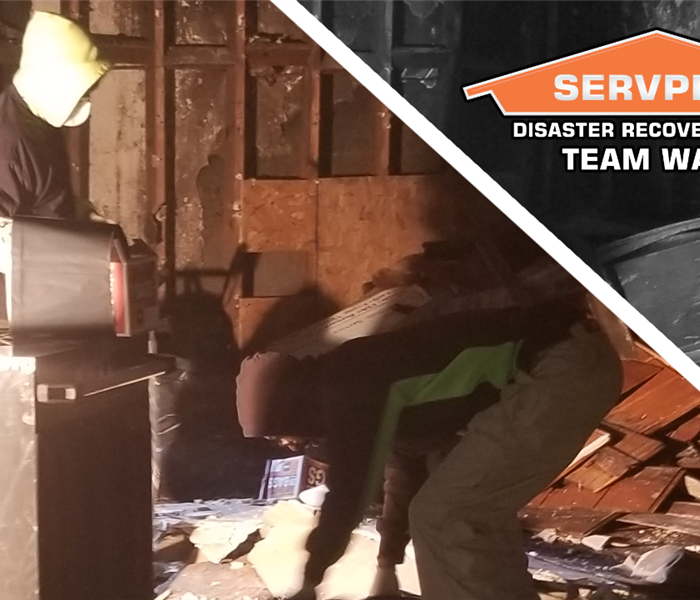 Always abide by safe cooking practices.
Always abide by safe cooking practices.
Many people cook on regular, day-to-day basis in their homes. However, did you know that cooking accounts for the majority of household fires? While abstaining from cooking would effectively prevent such fires, that solution is simply unreasonable due to the importance of cooking in our daily lives. However, abiding by safe cooking practices can decrease the chances of an undesired fire igniting while cooking, thus saving your home from potential unwanted fire damage.
Before Cooking
Preparing the cooking space holds an incredible amount of importance in preventing an unwanted cooking fire. Make sure that any flammable items, such as paper towels, oven mitts, or wooden objects, are a safe distance from the cooking area. Because grease, oil, and food debris accumulate on cooking surfaces, including stove tops and the interiors of ovens, and such residue can easily ignite, it is crucial that cooking surfaces are cleaned prior to cooking. Not unlike cooking surfaces, pots and pans should also be cleaned before cooking, as grease and oil can build up on the insides and outsides, which can ignite while cooking.
While Cooking
Clearing the cooking space of flammable objects and wiping down cooking equipment are great preventative measures to take before cooking, but even so, many things can go wrong if you leave the kitchen unattended. Fires can start while food is cooking and if no one is present, the fire could grow quickly and become hazardous, as there would be no one present to smother the fire as soon as one ignites. Make sure to turn off the stove if you plan on leaving the kitchen while cooking in order to decrease this risk. In the event that you are cooking an item that must be roasted or baked for several hours, it would be unreasonable to attend to it the entire time that it is cooking. In this case, use a timer to make sure that you are checking on the cooking process regularly.
While taking preventative measures such as wiping down cooking equipment and never leaving items unattended while they are cooking lessen the chances of an unwanted fire igniting while cooking, emergencies can still occur. Having functional smoke alarms installed in your home and making sure that a fire extinguisher is always kept in your kitchen are two ways to protect your home in the event that a dangerous fire ignites while cooking. If a small fire ignites, it may be safe to smother it yourself, but if the fire grows quickly and becomes out of control, assistance may be needed. In this case, escape the house safely, make sure all other occupants have exited, and call 911. Once the fire has been put out safely, remember to call SERVPRO in order to make sure that any damage caused to your home by the fire is sufficiently repaired.
Preventing Fire Damage in the Home
2/10/2020 (Permalink)
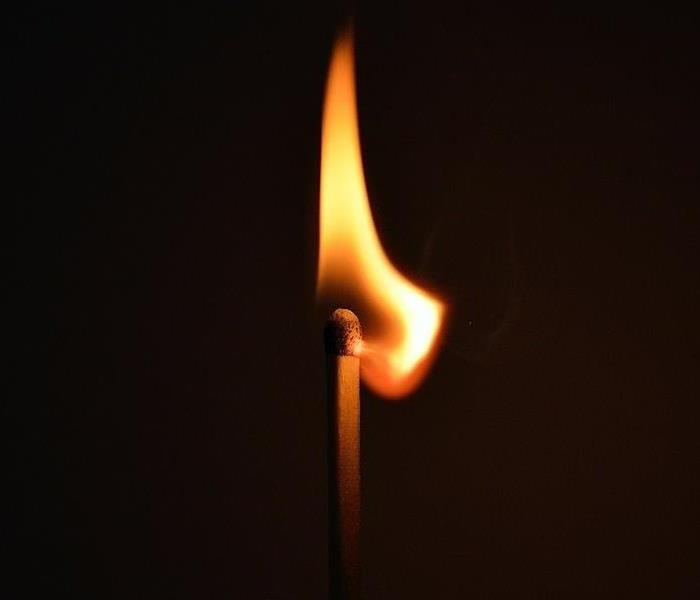 Fire Mitigation is important after you've experienced a devastating loss, however, knowing how to prevent it is incredibly valuable.
Fire Mitigation is important after you've experienced a devastating loss, however, knowing how to prevent it is incredibly valuable.
Preventing Fire Damage in Your Home
How Can Fires Start in Homes?
Several objects that are commonly found inside homes can cause fires including hair spray as well as other aerosol cans, shaving cream, hand sanitizer, and rubbing alcohol among others. It is necessary to be aware that these items are flammable in order to practice caution when handling them.
Electrical Dangers
Blown sockets as well as hot plugs and sockets can increase the risk of a fire igniting in the home. Flames can result from exploded wires that spark, however, a flame does not need to be present for there to be a chance of a fire starting.
Proceed With Caution When…
- Smoking Indoors
Careless smoking while indoors is the number one reason as to why fires start in homes, so extreme caution must be taken when smoking indoors. It is important to completely put out all cigarettes. Also, refrain from falling asleep with a cigarette still burning and using improper ashtrays.
- Burning Candles Indoors
While many of us burn candles inside regularly, it is still important to monitor them in order to protect against candle flames catching any other objects on fire. Candle flames can be blown by drafts such as those originating from open windows. If those drafts reach flammable objects, it can result in a larger and more dangerous fire. Also keep candles in proper candle holders in order to better constrict the flame.
Avoid These Combinations
Avoid placing certain household objects beside one another in order to decrease the risk of fire. Electrical appliances and water should not be placed within close proximity to one another, nor should grease be kept by an open flame or linens/clothes by a heater. Make sure to prevent flames from spreading to other objects from fireplaces by ensuring that it’s protected by a screen or glass doors.
5 Tips For Preventing Fires In Your Home
- Change out frayed wires for new ones
- Check the batteries in your smoke detectors every month
- Check heating devices in your home regularly
- Monitor objects placed on top of hot surfaces
- Store a fire extinguisher somewhere handy
Space Heater Safety
11/20/2019 (Permalink)
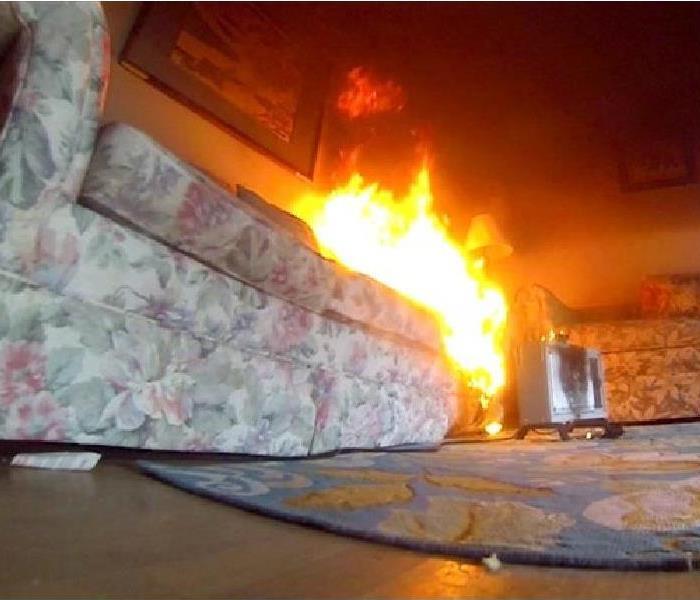 Dangers of plugged in Space Heaters
Dangers of plugged in Space Heaters
The ability to return to a cozy, heated home after spending time outside will become increasingly important as temperatures rapidly drop during November in Metro Pittsburgh East. While many homeowners utilize central heating systems to maintain warmth in their homes, many seek additional heat through space heaters. Creating a warm environment, space heaters can be helpful in heating a specific room, but space heaters do not come without safety risks. Space heaters caused an estimated 25,000 residential fires and 300 deaths each year, according to a 2013 study by The Consumer Product Safety Commission. While this statistic is alarming, your home’s individual risk can be decreased and your family can be kept safe with a thorough understanding of space heater safety.
Combustible objects, such as curtains, rugs, clothes, or paper can ignite if they come into contact with a space heater. To prevent a fire from starting, remember to always keep space heaters at least 3 feet away from combustible items while in use. Additionally, you should also be conscious of keeping your space heater situated on flat, level surfaces and away from major walkways in your home, as a fire could ignite if someone were to trip over the heater, knocking it over onto an object. Always be sure to check your space heater, including its cords and plug, for damage prior to usage. Damage increases the space heater’s risk of malfunctioning and creating a dangerous situation. Therefore, if you discover that the space heater has sustained any damage, do not use the unit. Finally, space heaters should never be left unattended during use. A nearby person could most likely detect a fire early on from the smoke smell and initial flames, which would decrease the chances of the fire spiraling out of control and protect the home from potential destruction. Therefore, it is imperative that you power down the space heater and unplug the unit before leaving the room.
Despite your best efforts to use space heaters safely, accidents can still happen. Taking precautions such as installing smoke detectors on every floor of your home can therefore serve as beneficial backup plans and help to protect your home from destruction. Lastly, if you have children or pets in your home, be sure to keep a watchful eye while a space heater is in use, as they could burn or injure themselves if they get too close. If your home sustains fire damage as a result of space heater usage this fall, you can count on SERVPRO for all of your restorative needs.
Fire Preparation
10/29/2019 (Permalink)
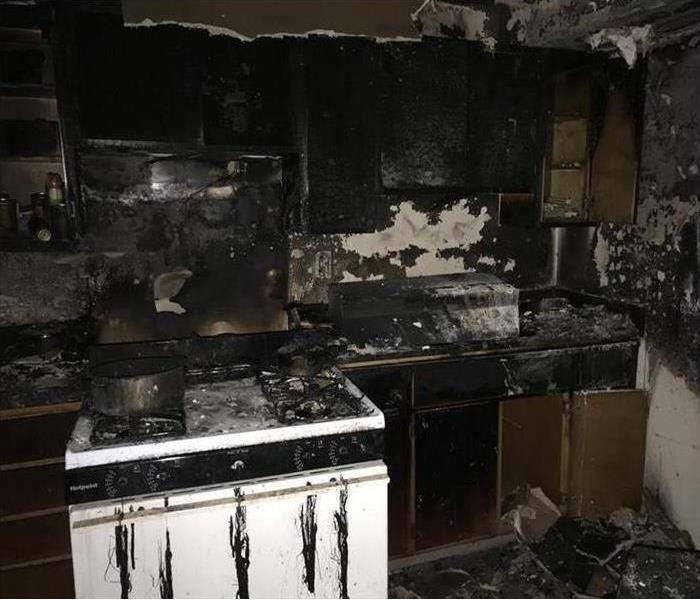 Kitchen fire in a two-bedroom apartment building.
Kitchen fire in a two-bedroom apartment building.
Summer time brings so much joy to children. After a long school year they finally get to relax and unwind. To parents and baby sitters however it leaves free time. A few tips on having children prepared in case of a fire:
- Teach your children what smoke alarms sound like and what to do when they hear one.
- Ensure that all household members know two ways to escape from each room, and know the family meeting spot outside of your home.
- Establish a family emergency communications plan and ensure that all household members know who to contact if they cannot find one another.
- Practice escaping from your house at least twice a year.
- Make sure everyone knows how to dial 9-1-1.
- Teach household members how to stop, drop and roll in case their clothes were to catch on fire.
For more tips and recommendation’s contact us. If an unfortunate event happens remember we’re here to help, and make it, "Like it never even happened."
Promoting Fire Safety in the Workplace
10/22/2019 (Permalink)
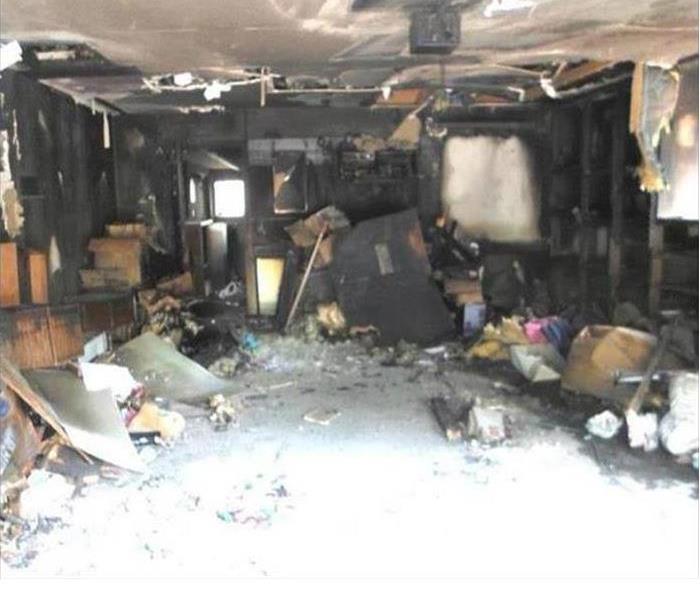 Garage Fire
Garage Fire
Promoting Fire Safety in the Workplace
When it comes to home fire safety, many of know the basics: regularly testing smoke alarms, replacing batteries, and knowing the location of our fire extinguishers. Workplace fire safety, however, is a bit more of a grey area. However, informing employees of potential fire hazards, what to do if a fire ignites, and how to exit the office building can prove imperative in protecting your workplace from the potential consequences of a harmful fire.
Taking preventative measures prior to a fire can decrease the probability of your workplace undergoing significant fire damage. Be on the lookout for damaged electrical appliances such as telephones, computers, and even desk lamps, as electrical complications can cause a fire to ignite. Upon discovering a faulty electrical appliance, remove it from the office space and replace it with a piece of equipment that functions properly. In addition, fires can also be prevented by informing office workers of how to properly utilize electrical equipment. Smoke alarms should also be installed throughout the workplace so that workers can be promptly alerted of a fire, allowing them enough time to escape the office. Just as you would in your home, check that the alarms are always working properly and regularly replace their batteries. These alarms should be dispersed throughout the workplace so that the alarm is audible to every employee, regardless of their location in the building.
While it is important to take preventative measures, it is also crucial to have an emergency plan in place that can be implemented in the event of a fire. Employees should know the ins and outs of the plan, including which exit to use and where to meet outside of the building. If employees understand this plan prior to an emergency, exiting the building as efficiently as possible will be a more feasible task. Lastly, all employees should know the location of fire extinguishers in the office and be able to operate them in the event that they are faced with a fire.
Taking preventative measures, always looking for fire safety hazards, and understanding the office’s emergency escape plan can protect your workplace from a potentially devastating fire.
Common Causes of Fires
10/16/2019 (Permalink)
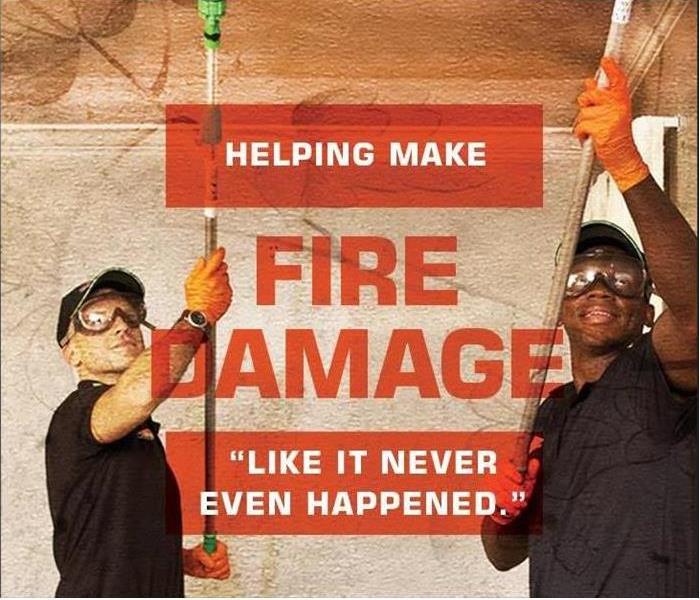 Helping make fire damage, "like it never even happened."
Helping make fire damage, "like it never even happened."
The top 5 most common causes of house fires and safety tips:
- Candles
- Never leave a candle burning near flammable items or in a child’s room.
- Make sure candles fit securely into candleholders so they do not tip over.
- Blow out any candles before leaving a room or going to sleep.
- Smoking
- If you smoke, consider smoking outside.
- Use wide, sturdy ashtrays to catch butts and ashes.
- Look for cigarette butts under furniture and between seat cushions to make sure no lit butts have fallen someplace where they cannot be seen.
- Do not smoke in bed, when you are tired or around medical oxygen.
- Electrical & Lighting
- Do not overload outlets or electrical cords.
- Make sure you have the right cord for the job. Inside cords for inside, heavy duty/outside cords for outdoor use.
- Do not leave Christmas lights, Christmas trees, or halogen lights on overnight or when not at home.
- Consider having an electrician perform an annual checkup of your home’s wiring.
- Dryers & Washing Machines
- Clean the lint screen frequently and do not run the dryer without it.
- For gas and propane dryers, make sure there are not any leaks in the lines.
- Check the vent of the dryer, outside of the house and ensure nothing blocks the vent pipe.
- Clean the vent pipe and the area where the screen is housed.
- Keep the area around the dryer free of combustible materials.
- Lightning
- Stay away from doors and windows during an electrical storm.
- Do not use computers, TVs or other electrical equipment during storms.
- Unplug major electronics: TVs, stereo equipment, computers and microwaves to minimize damage if there is a lightning strike close by.
- Avoid plumbing such as sinks, baths and faucets during a thunderstorm.
The overall ideas are thanks to the National Fire Protection Association.
National Preparedness Month and Fire Prevention Week
10/9/2019 (Permalink)
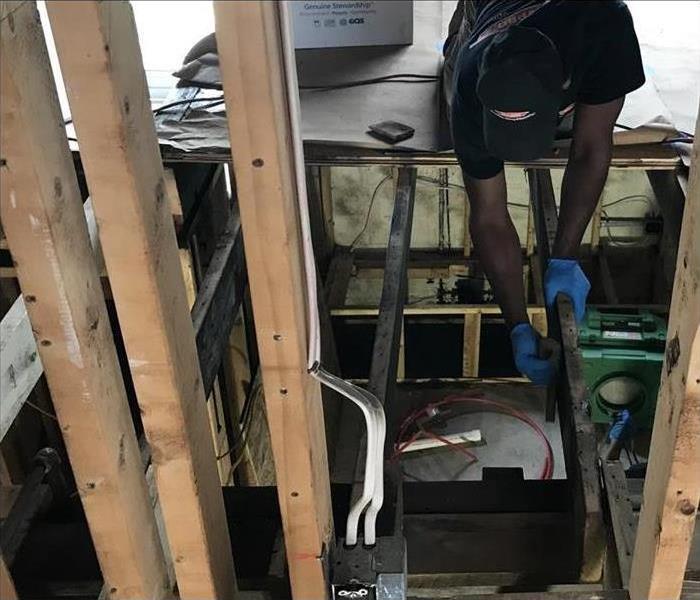 This house fire required the staff to demo the inside of the house. Burned out lumber was replaced and cleaned. The structure was painted and rebuilt.
This house fire required the staff to demo the inside of the house. Burned out lumber was replaced and cleaned. The structure was painted and rebuilt.
It is unfortunate that different types of disasters and emergencies happen in communities across the country, but there are key steps that every household can take to better prepare for them. If you do nothing else this month, take time to create a disaster plan including an emergency escape plan.
Make a clear plan of what to do in an emergency and in case of an evacuation. Identify clear roles for everyone in the house.
Discuss how to prepare and respond to emergencies that can happen at home, work and school.
Make a list of all the important things you may forget when in an emergency.
Have a disaster kit assembled for everyone in the house.
Have an out of the area emergency contact person noted.
Practice evacuating your home twice a year, especially if you have kids or pets. This makes it a routine and can make a real emergency situation less stressful.
The Red Cross provides one of many helpful apps for phones and tablets to help with emergencies.
http://www.redcross.org/get-help/prepare-for-emergencies/mobile-apps
Continuing Education Schedule
7/23/2019 (Permalink)
SERVPRO of Metro Pittsburgh is pleased to have the following continuing education schedule:
September 19, 2019 South Hills
Restorative Drying for Water Damage. 8:00 AM - 12:00 PM
Ethics 12:30 PM - 2:30 PM
October 15, 2019 Monroeville
Understanding the Restoration Industry - Property Fire Damage Restoration 8:00 AM - 12:00 PM
Biohazard Cleanup 12:30 PM - 2:30 PM
November 14, 2019 South Hills
Understanding the Restoration Industry - Property Fire Damage Restoration 8:00 AM - 12:00 PM
Biohazard Cleanup 12:30 PM - 2:30 PM
December 10, 2019 Monroeville
Understanding Mold in the Restoration Industry 8:00 AM - 12:00 PM
Mitigation Awareness and Response Seminar (MARS) 12:30 PM - 2:30 PM
All Monroeville Classes will be held at our office, located at 1951 Lincoln Highway, North Versailles PA 15137
All South Hills Classes will be held at the Spring Hills Suites, located at 611 Washington Road, Mount Lebanon PA 15228
Please call 412-825-5480 to register for any of these classes.
Your Home or Business Fire Exposure
5/6/2019 (Permalink)
No business owner wants to watch years of investment and effort go up in smoke. If your business, in Pittsburgh has gone through a fire, damage may be more extensive than you think.
A Fire May Touch All Parts of Your Business
Fires can be unbelievably destructive. Once smoke clears and fire crews leave, you may notice damage to all parts of your business. Damaged structures may include office buildings, warehouses, storage facilities and distribution centers. Further, inventory, office supplies, computers and equipment may sustain fire damage as well.
Fire Containment
The best way to limit damage during a business fire is to extinguish flames as quickly as possible. Even if your business did not turn into a raging inferno, you may have to deal with the messes water, fire retardant and smoke left behind. Fortunately, you probably do not have to figure out cleanup on your own. A professional restoration technician from a reputable service likely has the equipment and knowledge to assess damage and recommend a restoration strategy.
While all fires are different, many have the potential to cause serious damage to your business. You should have a plan.
Contact SERVPRO of Metro Pittsburgh East for help!
How Our Professional Services Can Restore Your Fire Damaged Property
12/26/2018 (Permalink)
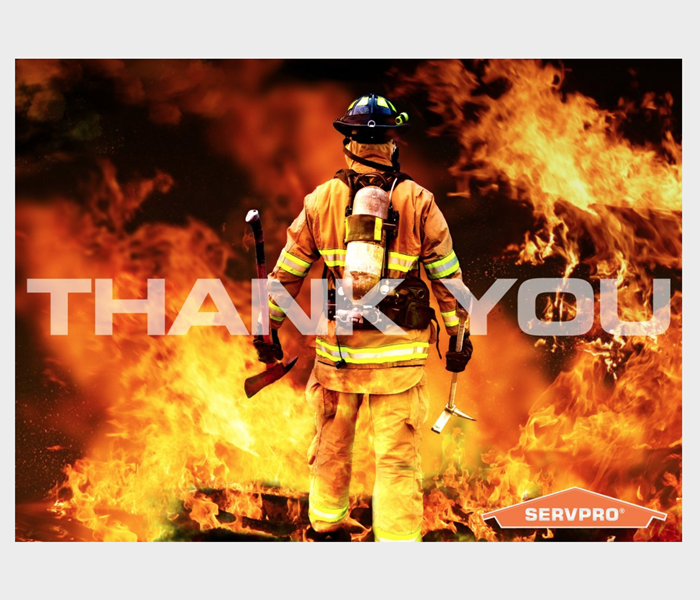 Thank you to our firefighters.
Thank you to our firefighters.
When materials burn they release carbon in the form of smoke.
The Use Of Sand Blasting, Water Pressure, And Air Pressure In Removing Fire Damage
When materials burn they release carbon in the form of smoke. As smoke comes into contact with a surface, it deposits parts of that carbon in the form of residue on that surface. These residues typically account for the lion's share of cleaning duties when restoring property after a small kitchen or living room fire. Although these types of fire are usually easily contained the smoke, which travels into open oxygen pockets, can spread far and wide. However, smoke residues contain more than just carbon, which is why professional cleaning services are a wise choice in the aftermath of soot or smoke harm.
A trained technician should be able to recognize the different types of fire and property owners can benefit from this expertise.
At SERVPRO we have a range of different cleaning methods and techniques to tackle all damages. Synthetic materials, for example, can release carcinogens when burned. Likewise, differing temperatures, airflows and fabrics require a tailored cleaning response.
On arrival at your property, a SERVPRO technician can conduct a pre-test. This involves testing different areas of the property for the type of damage.
Wet-smoke, caused by burning synthetics, is particularly susceptible to wet cleaning methods. Dry smoke, on the other hand, may benefit from dry cleaning to avoid spreading smoke around and inadvertently causing further damages.
In fire fighting efforts, there is a high chance that water is used which can set soot and make it tricky to clean. One technique that can be used to tackle soot is water pressure and air pressure. These advanced techniques help to dislodge soot from the surface, which can then be washed away. If there is significant structural damage, we could use sandblasting to rapidly smooth the affected area and remove charring or ingrained soot.
As part of a franchise with access to national resources, SERVPRO can afford to train our technicians to the highest level. With expertise in odor control, certified by the IICRC, and industrial fogging equipment, we can help to remove the unpleasant burning odors that may remain long after a property is restored.
Winter Heating Hazards
11/26/2018 (Permalink)
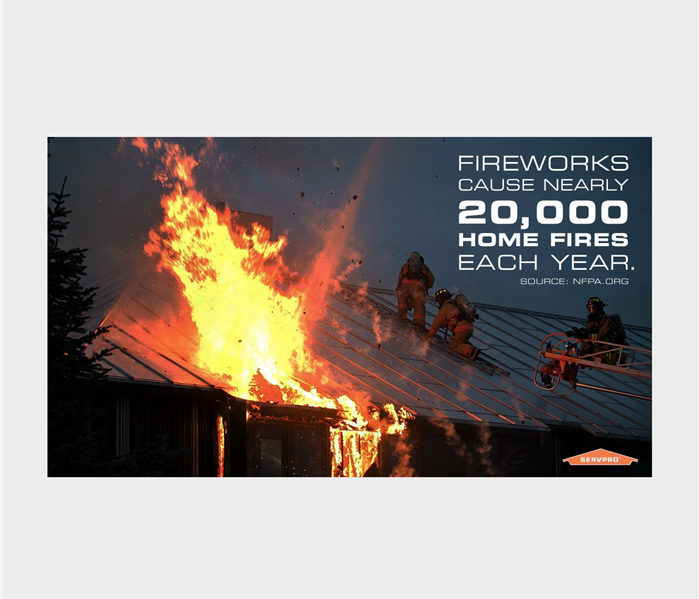 Fireworks cause nearly 20,000 home fires each year. ?Source: NFPA.org.
Fireworks cause nearly 20,000 home fires each year. ?Source: NFPA.org.
Winter is the same anywhere you go, lower temperatures and shorter days. Often times we use alternative heat sources like fireplaces, portable space heaters, and wood burning stoves to make our homes cozy. Did you know that heating equipment is a leading cause of home fire deaths?
Keep the following safety tips in mind to help reduce your risk of a heating-related fire:
- Keep anything flammable at least three feet away from heating equipment, like the furnace, fireplace, wood stove, or a portable space heater. Have a three foot "kid-free zone around open fires and space heaters.
- Make sure the fireplace has a sturdy screen to stop sparks from flying into the room. Ashes should be cool before putting them in a metal container. Keep the container a safe distance away from your home.
Remember to turn portable heaters off when leaving the room or going to bed.
Always use the right kind of fuel, specified by the manufacturer, for fuel burning space heaters.
Have heating equipment and chimneys cleaned and inspected every year by a qualified professional.
Have a qualified professional install stationary space heating equipment, water heaters or central heating equipment according to the local codes and manufacturer's instructions.
Test smoke alarms monthly.
Fire Preparation
10/29/2018 (Permalink)
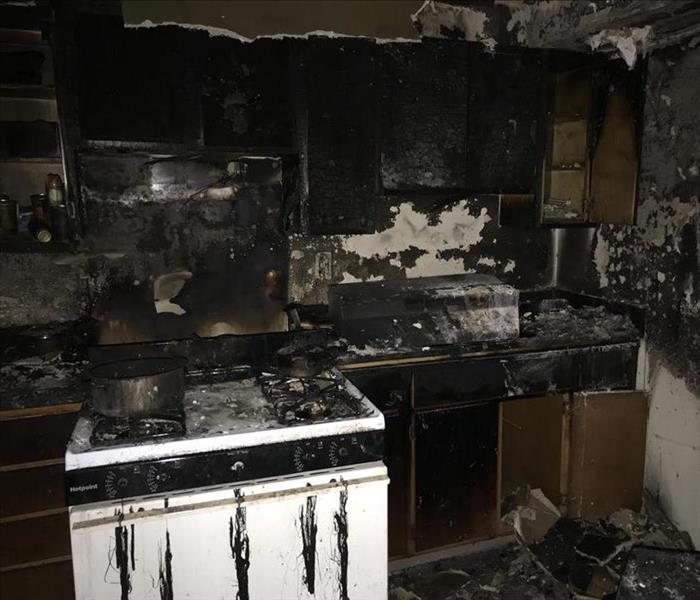 Kitchen fire in a two-bedroom apartment building.
Kitchen fire in a two-bedroom apartment building.
Summer time brings so much joy to children. After a long school year they finally get to relax and unwind. To parents and baby sitters however it leaves free time. A few tips on having children prepared in case of a fire:
- Teach your children what smoke alarms sound like and what to do when they hear one.
- Ensure that all household members know two ways to escape from each room, and know the family meeting spot outside of your home.
- Establish a family emergency communications plan and ensure that all household members know who to contact if they cannot find one another.
- Practice escaping from your house at least twice a year.
- Make sure everyone knows how to dial 9-1-1.
- Teach household members how to stop, drop and roll in case their clothes were to catch on fire.
For more tips and recommendation’s contact us. If an unfortunate event happens remember we’re here to help, and make it, "Like it never even happened."
Common Causes of Fires
10/12/2018 (Permalink)
 Helping make fire damage, "like it never even happened."
Helping make fire damage, "like it never even happened."
The top 5 most common causes of house fires and safety tips:
- Candles
- Never leave a candle burning near flammable items or in a child’s room.
- Make sure candles fit securely into candleholders so they do not tip over.
- Blow out any candles before leaving a room or going to sleep.
- Smoking
- If you smoke, consider smoking outside.
- Use wide, sturdy ashtrays to catch butts and ashes.
- Look for cigarette butts under furniture and between seat cushions to make sure no lit butts have fallen someplace where they cannot be seen.
- Do not smoke in bed, when you are tired or around medical oxygen.
- Electrical & Lighting
- Do not overload outlets or electrical cords.
- Make sure you have the right cord for the job. Inside cords for inside, heavy duty/outside cords for outdoor use.
- Do not leave Christmas lights, Christmas trees, or halogen lights on overnight or when not at home.
- Consider having an electrician perform an annual checkup of your home’s wiring.
- Dryers & Washing Machines
- Clean the lint screen frequently and do not run the dryer without it.
- For gas and propane dryers, make sure there are not any leaks in the lines.
- Check the vent of the dryer, outside of the house and ensure nothing blocks the vent pipe.
- Clean the vent pipe and the area where the screen is housed.
- Keep the area around the dryer free of combustible materials.
- Lightning
- Stay away from doors and windows during an electrical storm.
- Do not use computers, TVs or other electrical equipment during storms.
- Unplug major electronics: TVs, stereo equipment, computers and microwaves to minimize damage if there is a lightning strike close by.
- Avoid plumbing such as sinks, baths and faucets during a thunderstorm.
The overall ideas are thanks to the National Fire Protection Association.
National Preparedness Month and Fire Prevention Week
10/9/2018 (Permalink)
 This house fire required the staff to demo the inside of the house. Burned out lumber was replaced and cleaned. The structure was painted and rebuilt.
This house fire required the staff to demo the inside of the house. Burned out lumber was replaced and cleaned. The structure was painted and rebuilt.
It is unfortunate that different types of disasters and emergencies happen in communities across the country, but there are key steps that every household can take to better prepare for them. If you do nothing else this month, take time to create a disaster plan including an emergency escape plan.
Make a clear plan of what to do in an emergency and in case of an evacuation. Identify clear roles for everyone in the house.
Discuss how to prepare and respond to emergencies that can happen at home, work and school.
Make a list of all the important things you may forget when in an emergency.
Have a disaster kit assembled for everyone in the house.
Have an out of the area emergency contact person noted.
Practice evacuating your home twice a year, especially if you have kids or pets. This makes it a routine and can make a real emergency situation less stressful.
The Red Cross provides one of many helpful apps for phones and tablets to help with emergencies.
http://www.redcross.org/get-help/prepare-for-emergencies/mobile-apps
Steps To Clean Up a Fire
7/6/2018 (Permalink)
Our SERVPRO of Metro Pittsburgh East team has specialized fire restoration training needed to restore your home or business to pre-fire condition fast. To make it, "Like it never even happened."
The steps listed below illustrate how to approach “typical” fire damage that occurs:
1. Connect With Emergency Contact
2. Inspection and Fire Damage Assessment
3. Immediate Board-Up and Roof-Tarp Service
4. Water Removal and Drying (if water damage is present)
5. Removal of Smoke and Soot from All Surfaces
6. Cleaning and Sanitizing
7. Restoration
For more details on the proper steps to follow after a fire, check out the fire damage sections on our SERVPRO of Metro Pittsburgh East website.
http://www.SERVPROmetropittsburgheast.com/fire-repair-process
http://www.SERVPROmetropittsburgheast.com/commercial-fire-damage
Smoke Alarm Safety
7/2/2018 (Permalink)
Research shows that when a smoke alarm sounds off in a household, that you have less than 2 minutes to get out of the house for safety. This means that families must have a very specific plan of action when it comes to fire safety.
Smoke alarms need to be replaced every 10 years. The smoke alarm batteries (9-volt battery) needs to be replaced at least once per year. Although some smoke detectors are hard wired. Smoke alarms should be tested every month.
Having a smoke alarm properly installed in your home can be the difference between life and death. Reports from the U.S. Fire Administration state that three out of five home fire deaths are a result of smoke alarms that do no work.
There are a few additional tips beyond replacing smoke alarms every 10 years and batteries every year that each person should know. When discussing your evacuation with your family it is important to exit immediately. Smoke alarm placement is key. Be sure to have a smoke alarm inside and outside of any and all sleeping areas and bedrooms as well as installing alarms on every level of a home. It is best if the smoke alarms are interconnected. New versions of the smoke alarms contain carbon monoxide detectors as well.
If you or a loved one has suffered from fire damage in your home, SERVPRO is here to help you recover from the tragedy. Contact our team of fire damage cleanup professionals to learn more about your restoration options today.
What to Do Before Help Arrives
12/18/2017 (Permalink)
SERVPRO of Metro Pittsburgh East is always here to help and we want to make sure that everyone stays educated so that way we can find ways to avoid home disasters.
Here are some recent home fire facts to keep in mind when replacing smoke detectors and keeping our homes as safe as possible.
- Having a working smoke alarm can cut the risk of home fire deaths in half.
- It's important to know the difference between hardwired and battery powered smoke detectors. Hardwired alarms operate 90% of the time and battery powered ones only work 84% of the time. Which is a pretty decent difference when it comes to a home fire.
- According to a National Fire Prevention Week survey only 1/3 of Americans have both developed and practiced a home fire escape plan.
It is important to have a plan in motion. If you need help developing a fire escape plan SERVPRO would gladly help you along. Or you can visit www.nfpa.org for more information.
Air Duct Cleaning
12/18/2017 (Permalink)
There are many reasons why your home could use an air duct cleaning.
Dust levels in homes increase due to dirty air ducts, this is one of the many ways that particulates can enter your home. Other ways are through cooking, cleaning, smoking or just moving around. There hasn't been and concrete evidence that household dust can pose different health risks but there are other things to be on the look out for that can be potentially dangerous.
How to tell if you need to have your air ducts cleaned out:
- There is substantial visible mold growth on ducts.
- Ducts are infected with vermin (rodents or insects)
- Ducts are clogged with excessive amounts of dust/debris
You may just want to consider air duct cleaning simply because it is logical that the air ducts will get dirty over time and occasionally need to be cleaned.
Whether or not you decide to have your ducts cleaned, preventing dirt from entering the system is the most effective way to prevent any contamination from entering your home or business.
Dealing With Fire Damage In Your Pittsburgh Area Home
12/18/2017 (Permalink)
Pittsburgh Properties: Post Fire & Smoke Damaging Occurrences
After a fire happens on your property, you may be anxious to clean things up right away and attempt to get started on your own. However, unless you have professional cleaning experience or gain advice from a cleaning expert, you may be wasting your effort, or cause even further damage.
A properly trained restoration technician can help you determine whether the items that receive fire damage in your Pittsburgh home, are worth trying to restore, or if they need replacement. These professional fire restorers can provide you with recommendations that help prevent further damage and give you estimates on services for cleaning and deodorizing the entire affected area.
Fire and water damage restoration companies, like SERVPRO, follow strict guidelines when providing repair and cleaning services in your home. They take the time to secure the area, prevent hazards, and help limit the damages that you experience during this type of disaster. Getting help is the best way for you to assist with recovering from accidents that occur on your property.
SERVPRO offers a variety of services that includes the removal of soot and smoke residues that form on various surfaces throughout your home during a fire. Household textiles such as carpeting and draperies often require several attempts before cleaning and deodorization services are complete. Not doing so may cause odors to return.
It is important to make quick, precise decisions when considering your options after an event happens in your home. Time is essential, making dealing with smoke odors in your clothing, furniture, and other household items critical to prevent odors from lingering for days, weeks, or even months. Having a professional restoration company helps get things under control quicker and removes these odors in a more efficient manner.
SERVPRO technicians use industrial-grade water extraction equipment to remove water used during fire fighting efforts and have years of experience using cleaning methods to get the job done right. They are locally owned and operated, giving them the ability to provide you with what you need to get things back to normal fast.
Contact SERVPRO of Metro Pittsburgh East for additional information about available services or help regarding a fire, water, storm, or mold situation happening in your home today at (412) 672-5400.
Shadyside Properties Receive Smoke & Fire Damage Cleanup from SERVPRO
12/18/2017 (Permalink)
Your chimney and flue add architectural interest to your home, but the real function of your chimney is to take dangerous flue gasses from the wood stove, fireplace, or furnace out of your home safely. It helps the air in your household stay breathable, just like your windows in your kitchen vents, bathroom windows, and attic. However, unlike the other exhaust points in your home, wood stove and fireplace chimneys need a particular kind of care.
In action, a chimney fire in your Pittsburgh home can be impressive and cause you to need fire damage repair from a professional remediation company such as SERVPRO. Indications there is a fire in your chimney includes plenty of dense smoke, a loud popping or cracking noise, and a hot, intense smell.
Chimney fires can be dramatic and noisy enough to be detected by people passing by or your neighbors. Dense smoke or flames could shoot out from the top of the chimney. It has been reported by homeowners that they were startled by a low rumbling sound which is reminiscent of a low flying airplane or a freight train.
Undetected Chimney Fires
Chimney Fires which are slow-burning do not receive enough air or have the fuel to be visible or dramatic, and they many times go undetected until an inspection of the chimney later. However, very high temperatures are reached and can create as much damage to the chimney structure, and parts of the house close to it, as their more spectacular counterparts explosive fires.
Chimney Fires and Creosote
Wood stoves and fireplaces are made to contain wood-fuel fires safely while heating your home. Chimneys have the job of getting rid of combustion by-products, which are the materials made from burning wood, including water vapor, smoke, gasses, wood particles that are unburned, tar fog, hydrocarbon, and different minerals. As these materials are rising and flow into the cooler chimney, condensation occurs. The residue which that is left sticks to the inside walls of the chimney and is known as creosote.
Black or brown in appearance, creosote can be flakey and crust, shiny and hardened, or drippy and sticky. All forms can occur in a chimney. No matter the form it takes, creosote is very combustible, so if enough quantity builds up and the temperature of the inside of the flue is high enough, you could be dealing with a resulting chimney fire.
When a fire in your chimney damages your home, SERVPRO is always ready to help you clean up the mess and repair the damage. Smoke and odor remediation and indoor air quality are focal points of a SERVPRO service. It is, however, important to have your chimney regularly cleaned to try and avoid this problem in the first place.
SERVPRO of Metro Pittsburgh East and surrounding areas, knows how damage chimney fires can be to your home. Give them a call as soon as possible after the fire is out at (412) 672-5400, so they can prevent further damages from occurring.
What Will Your Sign On the Door Read?
12/18/2017 (Permalink)
Information at Your Fingertips!
I recently had a conversation with a maintenance manager, John. His office shares space with one of the buildings he manages.
I asked, "John, what would happen to this facility if you were at one of your other locations and a emergency happened here?"
"Well, I would have to leave that site and travel here" he stated.
"But what if that building also had an emergency? Who would be able to get access to your mechanical room to get a situation under control?"
"Well, I have the keys. The managers all know to just call me."
"So you are managing a broken sprinkler line at site A and site B calls with a broken water line... What do you do" I asked.
John thought for a moment, I went on.
"John, you like to fish. You are out on the river with no cell service. How are the people who depend on that space being usable to stay productive going to manage a emergency in your absence?"
His organization had stretched him too thin and had failed to develop contingency plans to help him manage emergencies remotely. His basement office housed the only emergency plans and blueprints for the facility he was in. His office was kept locked when he was not around. And, as you can guess, he had the keys on his person.
Luckily, SERVPRO has a Solution!
The SERVPRO Emergency Ready Program (ERP). A quick cloud based collection of need-to-know information to handle building emergencies. It's not as exhaustive as a complete risk management program, but it can serve as a great starting point to begin those emergency preparedness discussions with important information that key people at every site should know.
Make sure a primary employee at every site has keys to the mechanical room and knowing where the shut off values are.
In John's case it was a relatively painless fix. Every site now has another person with a set of keys to the mechanical room and that data is fed into the ERP cloud so every business in the building can access it. It was a time investment of less than two hours that almost certainly will save both time and money in an emergency.
The best part? John now has a plan to be able to prioritize his response and emergency needs. He also feels a little less worried when goes off grid.
For questions or to set up your no-cost Emergency Readiness Program, call 412-672-5400.
What To Do After a Fire
12/18/2017 (Permalink)
The first 48 hours after a fire damage can make the difference between restoring versus replacing your property and personal belongings. SERVPRO of Metro Pittsburgh provides timely response with mitigation services ranging from fire, smoke and soot removal to contents claims inventory and document restoration. These services help ensure your property, belongings and memories are restored to preloss condition when possible.
What You Can Do Until Help Arrives
- Limit movement in the home to prevent soot particles from spreading and additional damage from occurring.
- Place clean towels or old linens on rugs and high traffic areas and upholstery.
- Coat chrome faucets, trim and appliances with petroleum jelly or oil.
- Place aluminum foil or wood blocks between furniture legs and wet carpet.
- Do not wash any walls or painted surfaces.
- Do not shampoo carpet or upholstery.
- Do not clean any electrical equipment.
- Do not send clothing to a dry cleaner since improper cleaning may set smoke odor.
SERVPRO of Metro Pittsburgh is available 24-hours a day, 365 days a year to help you regain control quickly. Give us a call at 412-672-5400.
Holidays Spark Fires in the South Hills
12/18/2017 (Permalink)
Smoke residue comes in different varieties, and some are easier to clean than others. Dry, wet, protein and fuel oil smoke residues are all important to know how to remove. Take the guesswork out of cleaning and restoring your fire damaged property in South Knoxville by hiring our expertly trained technicians today. We're here to help you through the situation and return your property to its pre-damage condition. Our SERVPRO technicians understand that as a fire progresses through its stages, it can produce both wet and dry smoke. A different cleaning approach is needed to handle each type of residue left over by an event.
The smoke residue left behind depends on the rate of combustion, the amount of oxygen and kind of material or substance that burns throughout the entire fire. While we understand that if the event is fast-burning and oxygen-rich, it will produce dry smoke, while the fire is oxygen-starved, it will produce slow-burning, smoldering wet smoke. Natural Materials such as wood, paper, cork and other natural fibers create dry, small powdery residues that don't smear. However, synthetic materials like plastic and rubber often produce large easily-smeared particles.
SERVPRO technicians are trained to determine the conditions of a dry versus wet smoke event and apply the proper cleaning procedures to handle each particular situation.
Cleaning Dry Smoke Residues - These types of residues can be easier to clean. Dry smoke only contains a few aerosols that deposit small, dry particles on surface areas and usually don't stain as deeply as wet smoke. Meaning that the residues and odors left behind by dry smoke take less aggressive cleaning tactics to remove. However, dry smoke fires tend to burn hotter and therefore cause more heat damage than others do.
Cleaning Wet Smoke Residues - This type of residue consists of a large concentration of aerosols including varnishes, solvents, and other liquids. With these slow-burning fires, air currents aren't as high and give the wet smoke more time to creep into crevices and small enclosed areas that typically avoid damage in faster-burning fires.
We often run into circumstances at SERVPRO where many items exposed to wet smoke aren't restorable even though damage appears minimal. The aerosols end up penetrating surfaces and are absorbed into different materials, leaving large black particles behind and stripping stained finishes. Taking a minute to understand the possible reasons behind the causes of losing items in a fire is only one reason to hire us. We take a lot of pride in the work that we do for you and want to assist you during this trying time. Contact SERVPRO of Metro Pittsburgh East at (412) 672-5400. We work with your insurance company to restore your home back to it's prior condition!
Facts about Home Fires and Smoke Alarms
12/18/2017 (Permalink)
SERVPRO of Metro Pittsburgh East is always here to help and we want to make sure that everyone stays educated so that way we can find ways to avoid home disasters.
Here are some recent home fire facts to keep in mind when replacing smoke detectors and keeping our homes as safe as possible.
- Having a working smoke alarm can cut the risk of home fire deaths in half.
- It's important to know the difference between hardwired and battery powered smoke detectors. Hardwired alarms operate 90% of the time and battery powered ones only work 84% of the time. Which is a pretty decent difference when it comes to a home fire.
- According to a National Fire Prevention Week survey only 1/3 of Americans have both developed and practiced a home fire escape plan.
It is important to have a plan in motion. If you need help developing a fire escape plan SERVPRO would gladly help you along. Or you can visit www.nfpa.org for more information.
Fire Safety Events
11/29/2017 (Permalink)
In a matter of minutes, a home emergency can become a catastrophic loss. An emergency such as a small kitchen fire can quickly turn into a blaze spreading rapidly throughout your home or business. Will you know? Will you be alerted of such a problem before it is too late?
It is these types of scenarios that many individuals hope to never have to experience and therefore, typically do not spend time thinking about, “what if?”
That is why during the month of October, Firefighters and their associated departments host open-houses and fire-safety events with the goal of educating the public about preparedness and what to do in case of an emergency. These open-houses are filled with fire-safety activities and take-homes for kids to constantly remind them of how important preparedness and safety are. Many of the fire companies will even help you to make sure your smoke detectors are in good working condition and if they are not, they will help you to replace them.
In October 2017, SERVPRO of Metro Pittsburgh proudly participated in three of their local fire companies’ open-house events. We were there to help educate about fire-safety and focus on the aftermath in the event of a fire. We spent time with members of our community as well as with many members of our local, volunteer fire departments. Each open-house was unique but the goal for all three was simple: be prepared!
Summer Grilling Safety in Pittsburgh, PA
6/28/2017 (Permalink)
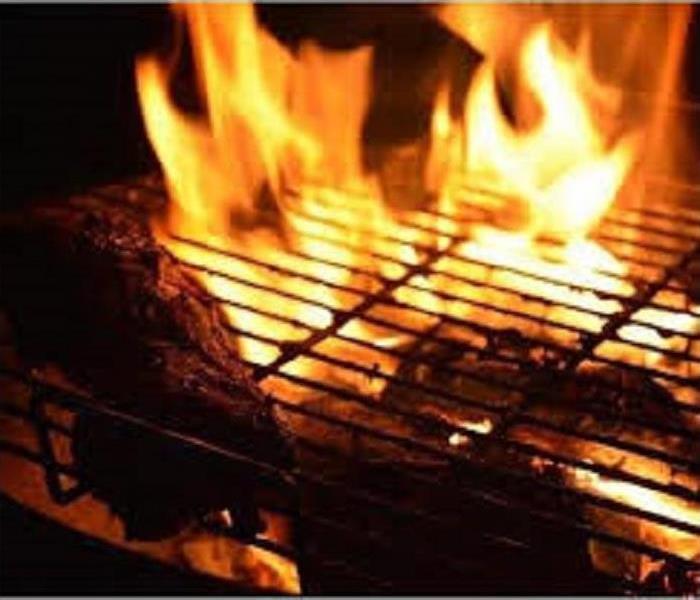 #SERVPROsummerFACTS
#SERVPROsummerFACTS
Grill Safety to consider when breaking out your inner backyard culinary skills.
June and July are peak months for summer grilling fires. The Memorial Day weekend is approaching quickly, it’s time to dust off the grills and let the inner backyard culinary skills to work. As exciting as it is to break out the grill for the official start of the summer season right, we have to always consider the safety that needs to be taken when preparing to light up the grill.
NFPA (National Fire Protection Agency) says that the U.S. fire department responded to an average of 8,900 home fire that involved the use of grills, hibachis, or barbecues per year. These 8,900 fires caused annual averages of 10 civilian deaths, 160 injuries, and $118 million in direct property damage. Almost all the losses resulted from structure fires. The leading causes of grill fires were a failure to properly cleaning of the grill, placement of the grill because it was placed to close to a structure, and leaving the grill unattended. Five out of six (83%) of grills involved in home fires were fueled by gas while 13% used other sources of fuel.
Precautions to take while grilling
Propane:
- Stay alert when grilling. Avoid grilling when you are tired or have consumed too much alcohol.
- Do Not leave your grill unattended.
- Keep the grill in a place that is free from flammable items and away from porch rails, and low lying branches.
- Keep children and pets as far away from the grill as possible
- Check the gas tank hose for leaks before using it for the first time each year.
NOTE: A light soap and water solution applied to the hose is a great way to check for leaks. You can often smell a propane leak, but propane will also release bubbles when the soap and water solution is applied. If you detect a leak, turn the gas tank and grill off. If the leak stops, get the grill serviced by a professional before using it again. If the leak does not stop, call the fire department.
- Always make sure your gas grill lid is open before igniting.
- If you smell gas while cooking, immediately move away from the grill and call the fire department. Do not move the grill.
- If the flames go out for any reason, turn the grill and gas off and wait at least 15 minutes before re-lighting it.
- Keep your grill clean by regularly removing grease or fat buildup from the grates and trays below.
Charcoal grill safety tips to consider:
- If you use a starter fluid, use only charcoal starter fluid. Never add charcoal fluid or any other flammable liquid to the flames.
- Keep charcoal fluid out of the reach of children and away from heat sources.
- Electric charcoal starters do not use fire. Be sure to use an extension cord for outdoor use.
- When you are finished grilling, let the coals completely cool before disposing in a metal container with a lid.
What To Do After a Fire
6/28/2017 (Permalink)
The first 48 hours after a fire damage can make the difference between restoring versus replacing your property and personal belongings. SERVPRO of Metro Pittsburgh provides timely response with mitigation services ranging from fire, smoke and soot removal to contents claims inventory and document restoration. These services help ensure your property, belongings and memories are restored to preloss condition when possible.
What You Can Do Until Help Arrives
- Limit movement in the home to prevent soot particles from spreading and additional damage from occurring.
- Place clean towels or old linens on rugs and high traffic areas and upholstery.
- Coat chrome faucets, trim and appliances with petroleum jelly or oil.
- Place aluminum foil or wood blocks between furniture legs and wet carpet.
- Do not wash any walls or painted surfaces.
- Do not shampoo carpet or upholstery.
- Do not clean any electrical equipment.
- Do not send clothing to a dry cleaner since improper cleaning may set smoke odor.
SERVPRO of Metro Pittsburgh is available 24-hours a day, 365 days a year to help you regain control quickly. Give us a call at 412-528-5480
'Tis the Season for Fire Damages in Metro Pittsburgh
11/21/2016 (Permalink)
 Don't let a fire ruin your holiday spirit- Call SERVPRO Metro Pitt to cleanup & restore.
Don't let a fire ruin your holiday spirit- Call SERVPRO Metro Pitt to cleanup & restore.
Smoke residue comes in different varieties, and some are easier to clean than others. Dry, wet, protein and fuel oil smoke residues are all important to know how to remove. Take the guesswork out of cleaning and restoring your fire damaged property in South Knoxville by hiring our expertly trained technicians today. We're here to help you through the situation and return your property to its pre-damage condition. Our SERVPRO technicians understand that as a fire progresses through its stages, it can produce both wet and dry smoke. A different cleaning approach is needed to handle each type of residue left over by an event.
The smoke residue left behind depends on the rate of combustion, the amount of oxygen and kind of material or substance that burns throughout the entire fire. While we understand that if the event is fast-burning and oxygen-rich, it will produce dry smoke, while the fire is oxygen-starved, it will produce slow-burning, smoldering wet smoke. Natural Materials such as wood, paper, cork and other natural fibers create dry, small powdery residues that don't smear. However, synthetic materials like plastic and rubber often produce large easily-smeared particles.
SERVPRO technicians are trained to determine the conditions of a dry versus wet smoke event and apply the proper cleaning procedures to handle each particular situation.
Cleaning Dry Smoke Residues - These types of residues can be easier to clean. Dry smoke only contains a few aerosols that deposit small, dry particles on surface areas and usually don't stain as deeply as wet smoke. Meaning that the residues and odors left behind by dry smoke take less aggressive cleaning tactics to remove. However, dry smoke fires tend to burn hotter and therefore cause more heat damage than others do.
Cleaning Wet Smoke Residues - This type of residue consists of a large concentration of aerosols including varnishes, solvents, and other liquids. With these slow-burning fires, air currents aren't as high and give the wet smoke more time to creep into crevices and small enclosed areas that typically avoid damage in faster-burning fires.
We often run into circumstances at SERVPRO where many items exposed to wet smoke aren't restorable even though damage appears minimal. The aerosols end up penetrating surfaces and are absorbed into different materials, leaving large black particles behind and stripping stained finishes. Taking a minute to understand the possible reasons behind the causes of losing items in a fire is only one reason to hire us. We take a lot of pride in the work that we do for you and want to assist you during this trying time. Contact SERVPRO of Metro Pittsburgh (412) 672-5400
13 Trends in the Restoration Industry
6/8/2016 (Permalink)
We find this an excellent article & have shared with many via email & our social media. Now we want to post it as a blog because it is great insight into our industry.
An article from "Restoration & Remediation" magazine, January 9, 2016
Written by Michelle Blevins and Michael A. Pinto, CSP, CMP
National Credentials, Struggling Franchises, Bureaucracy, & more...
Think back through 2015. Can you think of any changes in the restoration and remediation industry? Yep, I bet you probably can. There were some major changes to mold remediation regulations in New York State, updates to the ANSI/IICRC S500 and S520 standards, we lost an industry pioneer with the passing of Marty King, and there were numerous changes and updates to available equipment, software, etc. It’s a list that goes on and on. Change is inevitable.
Now, look ahead into 2016 and beyond. Do you have any predictions of what may lie ahead?
Michael Pinto, CSP, CMP, has published more than 200 articles and several books on IAQ, mold remediation and other remediation-related topics. As the CEO of Wonder Makers Environmental, Pinto also serves on the board of directors for the Indoor Air Quality Association and Cleaning Industry Research Institute. Seriously, his credentials go on and on. When it comes to this industry, he knows his stuff.
In November, Pinto spoke at PLR Expo and shared these 13 predictions for the future of this industry. Just before his presentation, Mr. Pinto approached me and offered up this presentation (in article form) to R&R’s readers, if I did the writing! So, I’m honored to take on the task of putting his future outlook into words. What you read below is straight from him – just put to paper by me.
1. National Credentials for Restoration Work
This is happening on different levels, primarily in government. After every major disaster, talks start again about possibly requiring specific credentials for people working in disaster zones. It’s a slow process that’s been going on for 15-20 years both in government and industry. It did start getting some legs after Hurricane Katrina. In Louisiana, some state-required certifications were widely ignored to the point it drew attention from the governor who waived certain rules for 60 days.
With franchises and industry organizations growing, there is more and more talk of credentials like this, especially among emergency managers. Those managers understand the risk involved in not having a larger organization to draw upon for credible workers in case of a disaster.
On the flip side, there are arguments against these credentials. They could slow down response, and in an emergency could create violators out of competent restorers.
Incidents like the recent terror attack in Paris could also fuel the effort toward pre-screening responders for mass casualty events. Such pre-screening could include background checks, plus OSHA compliance. During TV news coverage of the Paris attacks, we witnessed some of the biological matter on the sidewalks and streets being simply hosed off into the drains. Is that really the best way to deal with a mass casualty scene? Putting proper procedures in place could be a good starting point.
2. Government Will Continue to Dabble with Licensing, but Slowly
There continues to be inconsistency with licensing for mold, lead, and asbestos remediation. Basically, licensing is being driven by money and statistics. What we’re finding out in many places is the promise doesn’t always live up to the reality. Government expects these programs to be self-funded through fees, but it doesn’t always work out that way. Virginia once had a mold licensing law, but repealed it after three years because it was difficult to sustain.
If the licensing route isn’t chosen, restoration contractors could be forced to work together to form some kind of training regimen, similar to what happened in British Columbia. (http://bcarc.ca/)
3. Bureaucracy Will Get Worse
It’s hard for a government agency to be focused on customer service and public service simultaneously. From a structural and attitude standpoint, bureaucracy is getting worse, not better, and more aggressive enforcement will be at the expense of real assistance. The whole idea of the bureaucracy becoming kinder, friendlier, gentler is not a reality at all.
This kind of attitude can mean documentation suddenly becomes more important and a bigger part of the focus than the actual process. All the ducks have to be in a row before you even dream about serving a customer. There seems to be more of a “gotcha” mentality where agencies make examples of some businesses that make a mistake, rather than fostering growth and learning within businesses and helping them succeed, while following the rules.
4. Insurance Industry Splits
Look for the insurance industry to continue to split. You’ve already seen this a little bit with treatment of preferred vendors. Some insurance companies are trying to “vertically integrate” by buying lumber yards, hygiene firms, creating their own restoration companies, etc. Their thought process is if they’re already insuring the risk then providing the payout, so they essentially want to own the whole process from top to bottom. It’s unclear how far this will get.
On the other hand, some insurance companies understand the liability of having preferred vendors. It’s the one out of 1,000 cases that goes wrong that draws the wrong kind of attention and liability. So, these insurance companies are thinking about softening the relationships they have with preferred vendors.
In fact, some insurance companies are tending to prefer to go back to the “olden days” where there were more personal relationships between insurers, vendors, adjusters, etc., because they see where there can be problems among bigger companies, such as liability and customer service.
5. Franchises May Struggle
There is a case that could very well make it to the U.S. Supreme Court in which the government is trying to redefine who are contractors, subcontractors, temps, who owns them, etc. The government is trying to say a franchisor is a co-employer with the franchisees. That iscompletely opposite to why we set up franchises! They are meant to help with overall business functions, marketing, tools, training, etc., but franchisees are still running their own business.
Should that ruling get upheld that franchisors are co-employers with franchisees, there will be a huge ripple effect through the entire industry. All of a sudden, becoming a franchisee has more risk and the corporate people have to have a lot more input. It would also mean, under the Federal Health Care Law, every employee beneath the franchisor be offered a certain level of insurance. It would not work for someone in Los Angeles to carry the same liability as someone in Terra Haute, Ind.
On the flip side, cooperatives (DKI, Contractor Connection, Code Blue, IMACC, etc.) could benefit. It will be much more far-fetched to say coops made up of a number of independent contractors are co-employers because they do not have some of the same legal and financial ties.
6. Growing Public Awareness
This is particularly in reference to growing environmental issues and awareness. Restoration contractors deal with hazards and contaminants all day. When you introduce new chemicals, technology, and other products as quickly as we do (especially on the home building side – new paints, flooring, etc.), we are adding a lot of things into buildings that weren’t there even five years ago. And truth be told, manufacturers don’t always know how these are going to react over time, or in a loss like a fire or flood. Now – all those items are in these homes, and the restoration industry comes in with their new chemicals and machines to remediate. How do we know what’s really happening when all the chemicals and materials mix?
Have you heard the term WDB for Water Damaged Building? It’s a term growing in popularity as we learn there is a lot more going on in a WDB than just mold. We’ll talk more about this a little further in just a moment.
7. A Tighter Connection
There is a growing tie between medicine and the environment. Restorers and other professionals are increasingly aware about caring for “sensitized individuals.” Years ago, I (Michael Pinto) said there was too much anecdotal evidence of people getting sick after being in a mold-contaminated building for doctors to deny the problem, even if they don’t yet know the causative factors. Once they figure out a treatment drug and big pharma is involved, this will take off.
Today, there are symptoms, causes, and prescriptions for people sensitive to mold. Plus, we have discovered a genetic component that makes some people more sensitive to mold than others, and the naming of a related illness: CIRS. There is even a $15 non-invasive screening test for people to see if they’ve been exposed to mold.
There is also the Environmental Relative Moldiness Index, which analyzes dust samples for 26 different species of mold. Two-thirds of those species are considered to be indicators of water damage. Plus, the EPA has created a comparison chart to identify a WDB. (http://www.epa.gov/mold)
All of this could trigger permissible exposure limits. Technology is already catching up with the computerized Mold Propensity Index. For about $200, it provides remediation recommendations for a mold contaminated home.
8. A More Active Justice System
Just look at all the points above! There are a number of legal hazards out there – including mold, lead, water damage, and infectious diseases. We can expect similar results compared to how lawsuits from asbestos exposure have skyrocketed in recent decades.
9. Continued Bleed-Over of Technology
There is a lot more cross-over between industries. Technology and chemicals are finding numerous uses, often traveling from the health care industry to remediation and into restoration. For example, look at how foamers started in the agricultural industry and traveled to food service, then remediation, then restoration, then health care. Similarly, surface sanitizers went from health care to remediation to use with sensitized individuals.
It’s also important to note the use of hydroxyl generators in a variety of situations, and some remediators opting for different techniques with sensitized individuals like essential oils, salt solutions, Hydrogen peroxide, organosilane surface protectors, etc.
10. Action vs. Talk
More and more people are rejecting marketing and want scientific proof of claims regarding equipment, chemicals, and other products. Ebola made a big difference in this. There was (and still isn’t) a proven killer of the Ebola virus. People want proof products are doing the job correctly.
11. Green vs. Greenwash
Claiming something is green is no longer going to cut it. Like the point above, people want proof what’s being used in their home is safe. Therefore, the industry is taking meaningful steps toward green chemistry rather than greenwashing. On the safety side of this, there are huge studies going around about nanotechnology as we continue manipulating things on the molecular level. Those changes are in turn appearing to affect people, especially sensitized individuals. It’s a huge trend in the safety field.
12. Closer Cooperation Between Industry Associations
This is already happening! ASHRAE and the IAQA recently merged; APIC and ASHRAE coordinated on responding to the Legionella outbreak; RIA, IAQA, and the IICRC presented a united position on Florida’s mold law changes; ISSA and CIRI worked on a joint standard; and the IICRC currently has nine MOUs. As the world becomes more complicated, it takes more people to get it right – so collaboration becomes key.
13. Marketing Will Keep Shifting
The industry is already trending toward social media promotions and educating through marketing, rather than straight sales techniques. The way you reach customers today will likely be very different in years to come.
Don’t let this list scare you. The restoration and remediation world will continue to evolve, just as it always has. Staying ahead of the curve is key. So stay informed through industry training, conferences, webinars, publications, and other resources.
In the words of Doc Brown in Back to the Future III, “Your future is whatever you make of it, so make it a good one!”
Board-Ups and Fire Damage
6/8/2016 (Permalink)
A crew is called out by the production manager in the middle of the night. A residential fire is in process and will need a board-up. A crew chief arrives on the scene investigating how many windows are broken out; how many doors are broken out; is the house secure; what do we need to preserve for the fire marshal or investigators?
The next day estimators go out and listen to the family’s concerns regarding content/ belongings (china, urns with ashes, family heirlooms, etc.). If there are firearms in the house, a homeowner has to immediately remove these items on their own. SERVPRO teams learn what the family needs regarding clothing or temporary support and helps with resources. SERVPRO crew members begin packing out belongings to bring back to the franchise warehouse to ozone and clean according to restoration industry standards and SERVPRO best practices.
The signature touch? SERVPRO franchises are trained to help families and business owners who are devastated by fires, floods or other horrific circumstances – to care, to show the human side of the work. We certainly can make anything regarding a structure or contents “Like it never even happened.” but the emotional side of crisis takes a special team of people who understand, empathize, listen, and hold out their hand.
Fire Safety - Learn Not To Burn
6/8/2016 (Permalink)
Thanks to The Western Pennsylvania Hospital Burn Trauma Center for these Fire Safety Tips for the upcoming summer months:
IN YOUR YARD:
*Keep children away from BBQ grills.
*Use an electric starter to light your BBQ. Avoid lighter fluid, gasoline and newspaper.
*Keep hot coals in the BBQ until they are completely cooled. A child may pick up a hot coal left on the ground.
*Turn your lawnmower engine off and let it cool before adding gasoline.
*If burning leaves is permissible in your community, make sure the fire is in a contained area, and do not leave until the fire has been extinguished.
IT'S SPRING & SUMMER SO CLEAN YOUR BASEMENT:
*Throw away old newspapers, rags and other trash. These materials easily catch fire.
*Store flammable liquids such as gasoline, kerosene and paint outside in a cool, locked storage area. Do not store them in your basement or garage.
*Make sure power tools are properly grounded. Use the voltage specified on the tool or instruction manual.
IN YOUR CAR:
*Repair your car outdoors, not in a closed garage.
*Let an experienced mechanic handle all extensive repairs (priming the carburetor, etc.).
*Wait until the engine cools before unscrewing the radiator cap.
*Do not siphon gasoline or transport gasoline in the back of a truck.
SERVPRO of Metro Pittsburgh East- What Do They Do?
4/12/2016 (Permalink)
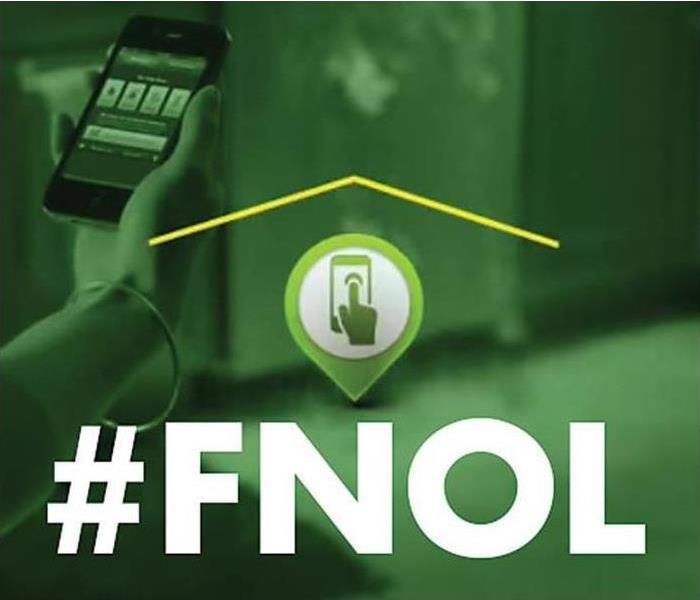 First Notice of Loss: It means- RAPID RESPONSE
First Notice of Loss: It means- RAPID RESPONSE
Second responders…
that would be the crew of SERVPRO pulling up to your house or business after a fire, helping you work through the insurance claim...
Helping you find your way when you are just overwhelmed. Our industry of clean-up and restoration is about working in the aftermath of a disaster. Sometimes we are second responders and sometimes we are first responders.
What kind of disasters?
Water loss (pipes breaking, toilets overflowing, showers left running) – think of floors, walls, behind the walls, ceilings, and then mold……water damage gets everywhere.
Fire (soot, odor, clothes/textiles, electronics, general contents) – think of how to deep clean and get back to normal.
Biohazard (someone cuts themselves in a police car, suicide, decomposed body, crime scene) – think of bloodborne pathogens and safety.
Hoarding (residential homes discovered, sometimes with several animals inside too) – think of the unsanitary conditions and packing out.
Mold (basements, old water loss never addressed properly, unventilated bathrooms) – think safest way to remove “this stuff”.
Air Ducts (overdue general cleaning) – think easy, oh wait, we just found mold.
Hurricane (national crisis) – think of a trained response team.
All of these examples represent some of the services SERVPRO Metro Pittsburgh East provides to residential and commercial clients. Our crews help individuals determine the best choices for clean-up, restoration and construction repair. Our multi-franchise team helps families and businesses get back to living or back to working as quickly as possible after a crisis.
We know there are many choices in the clean-up and restoration business, however, we are the largest SERVPRO franchise in western Pennsylvania related to employees and equipment inventory. We have operated in the region for more than 14 years under the same owners (Metro-Pitt, South Hills and Monroeville).
Plus Metro-Pitt has operated in the community for more than 25 years. This is the kind of experience you want on your side when things go madly wrong.
Keep our phone numbers in your devices: (412) 672-5400 / 1-877-824-0565.
 Consider these 3 proactive fire safety tips that are beneficial to keep in mind while cooking in the kitchen.
Consider these 3 proactive fire safety tips that are beneficial to keep in mind while cooking in the kitchen.





 24/7 Emergency Service
24/7 Emergency Service













